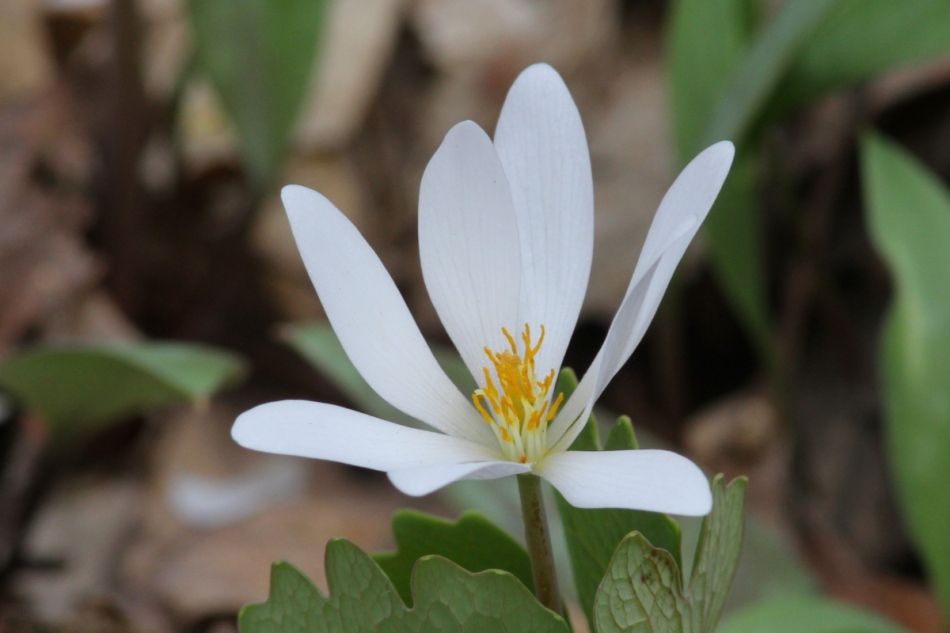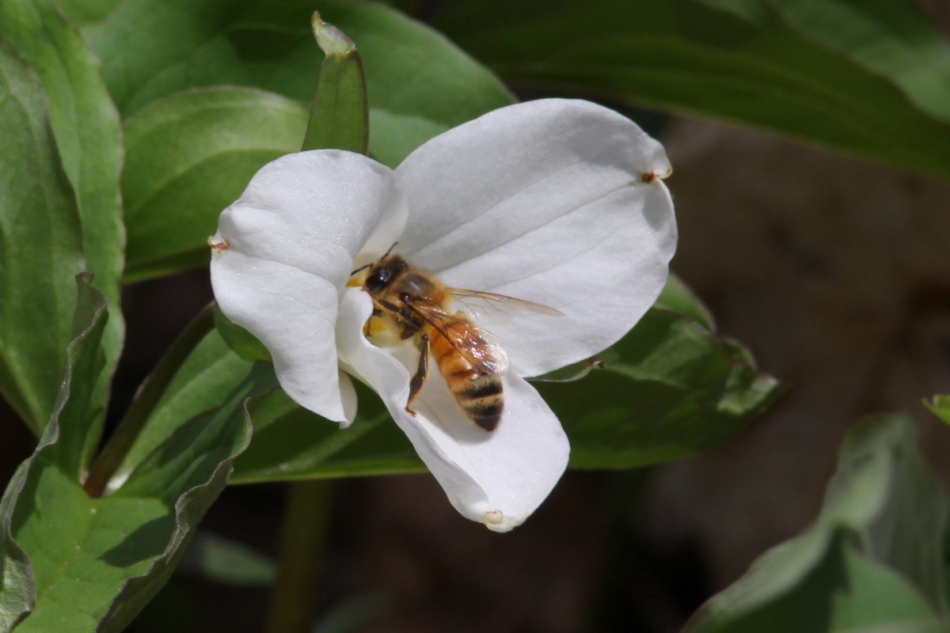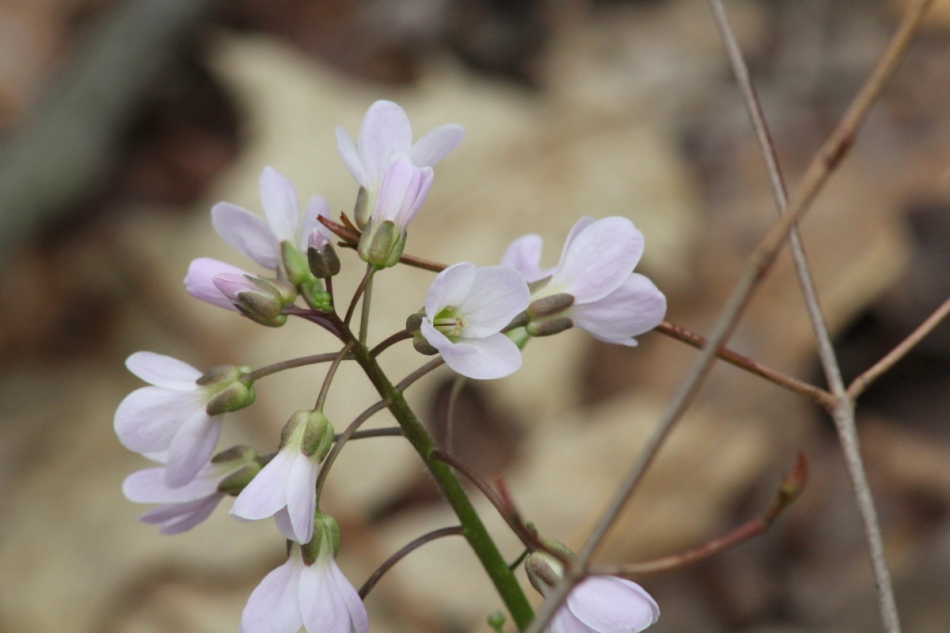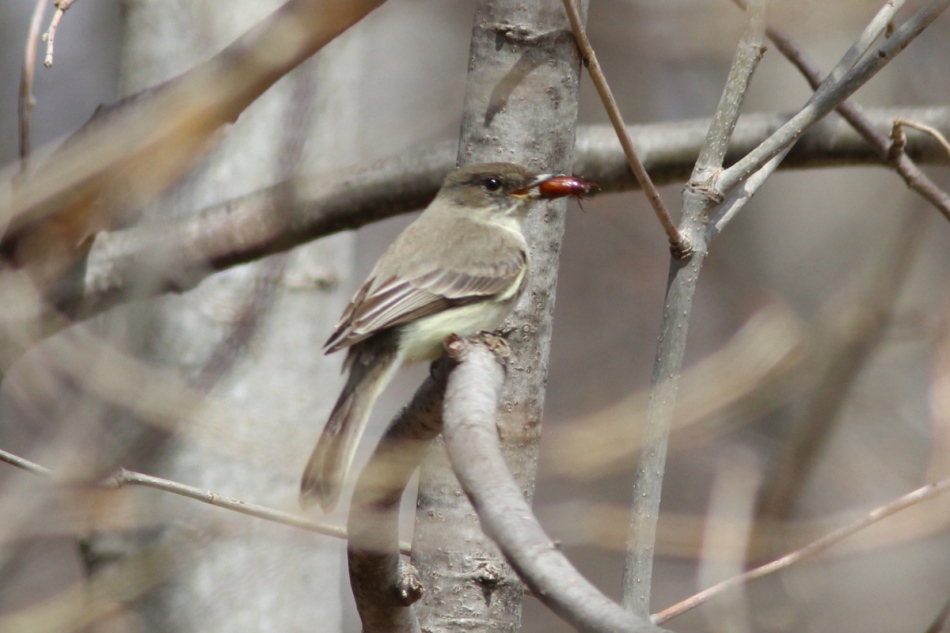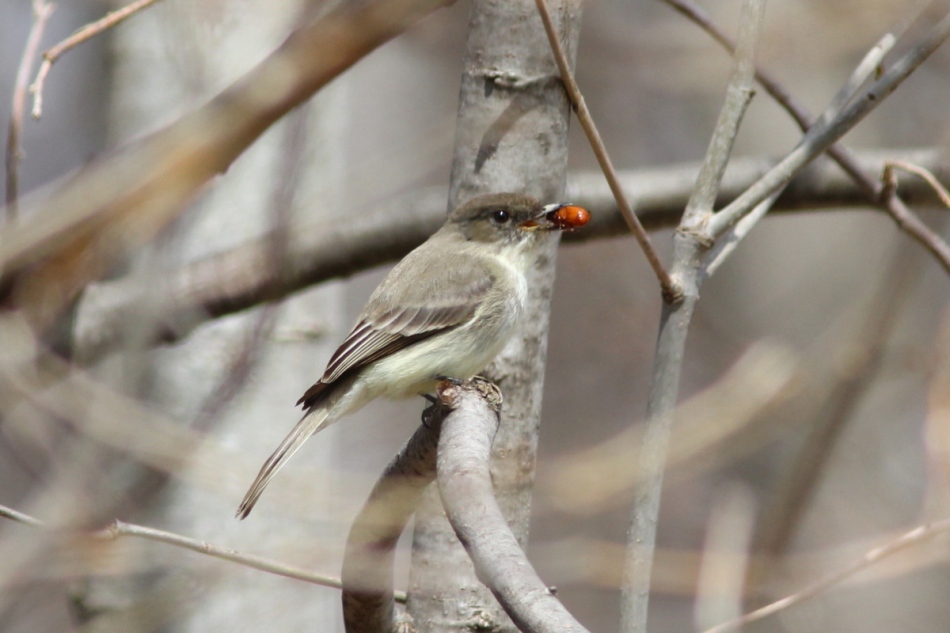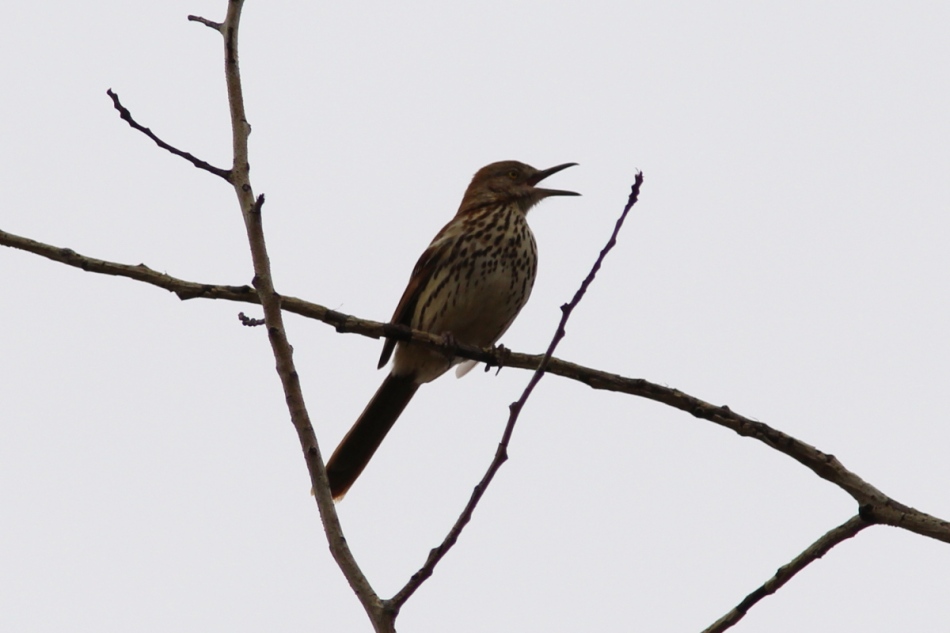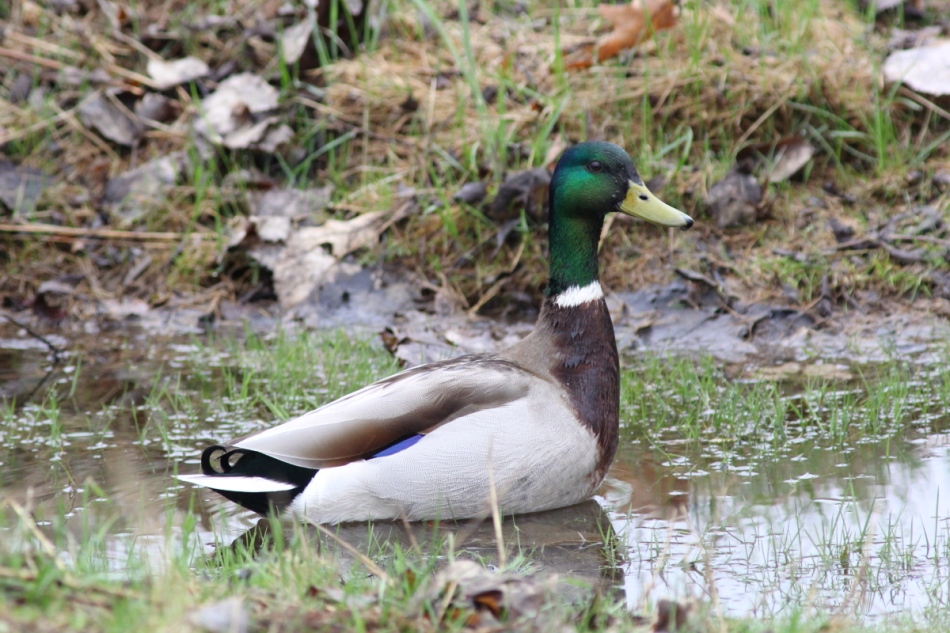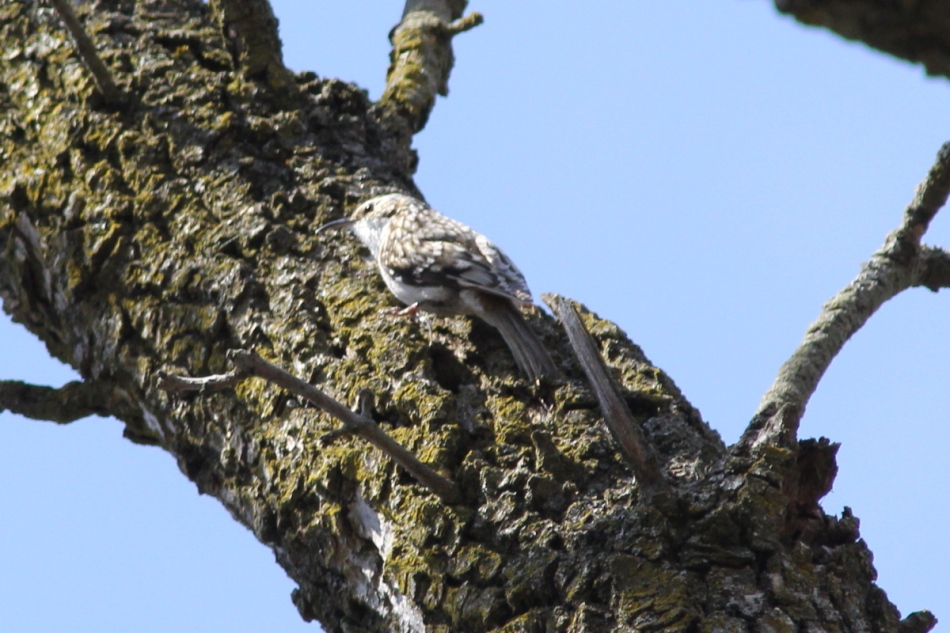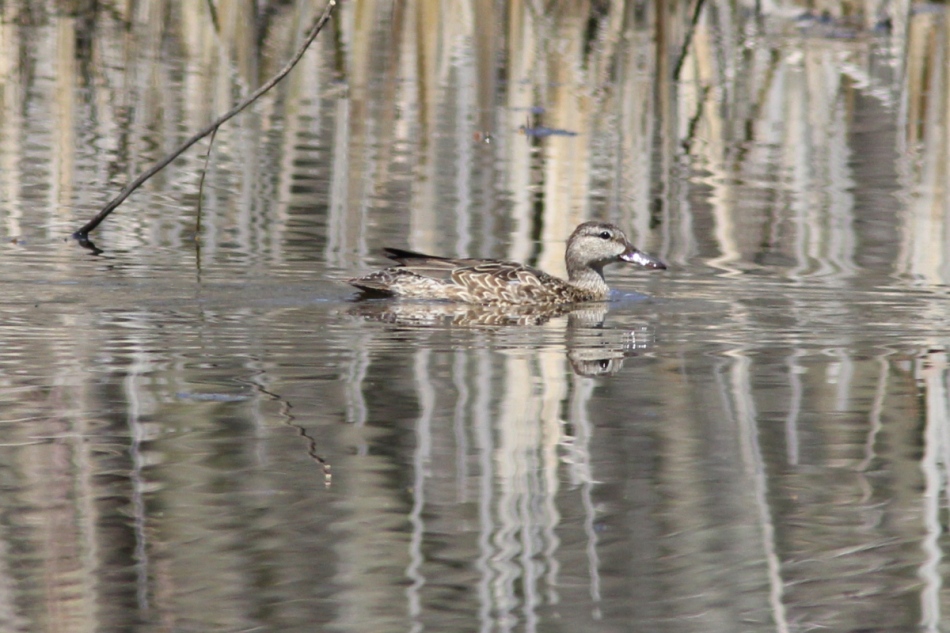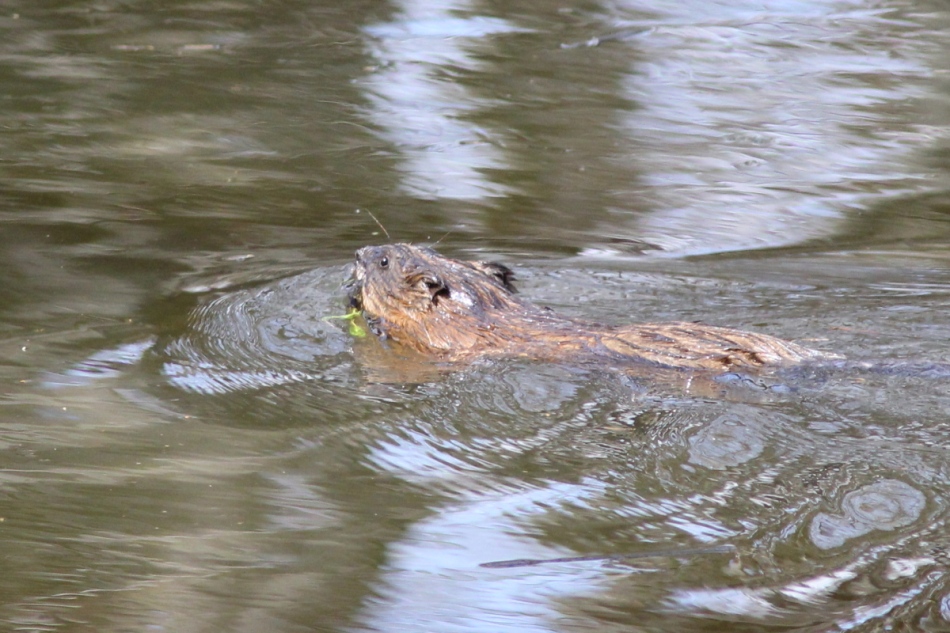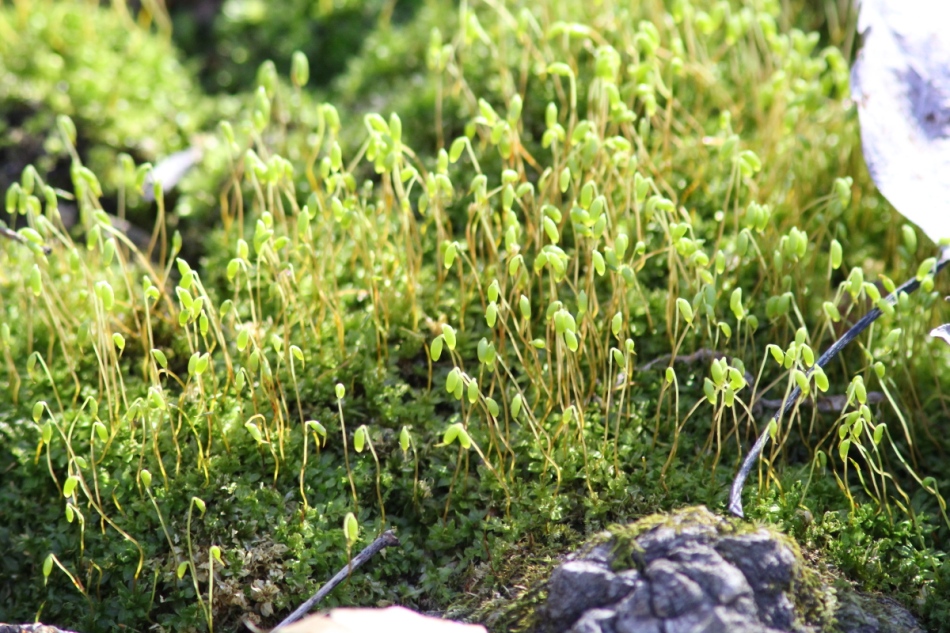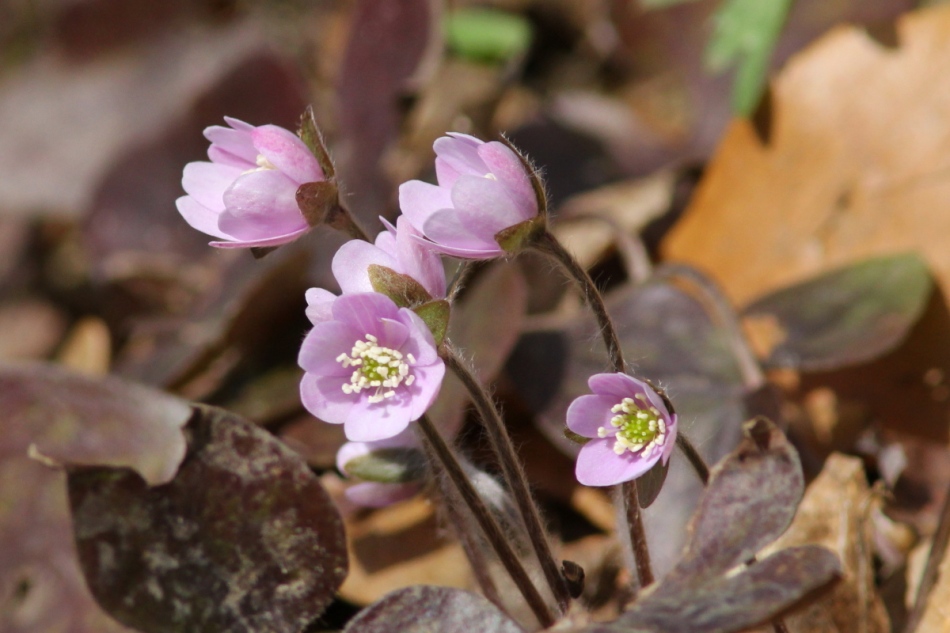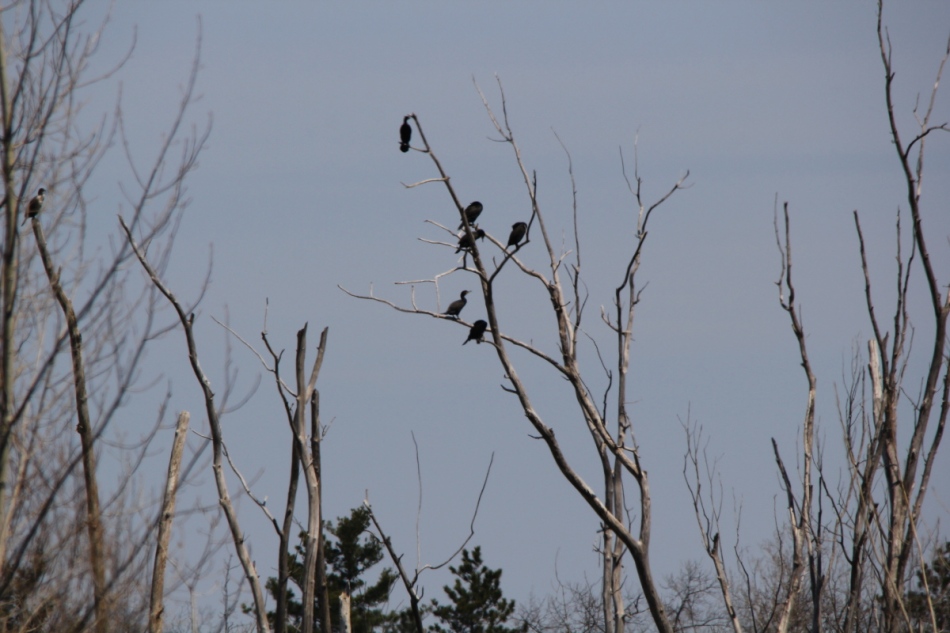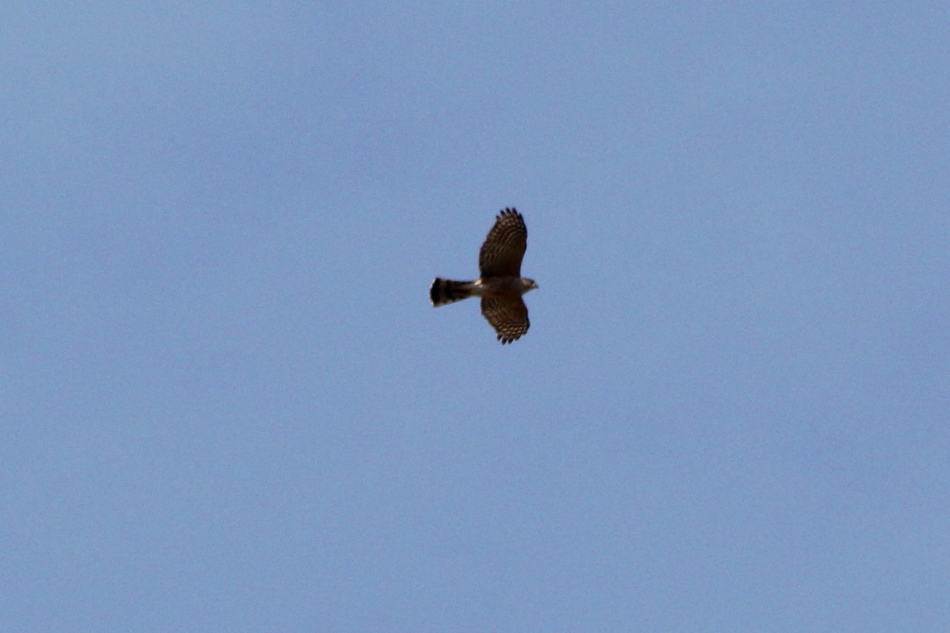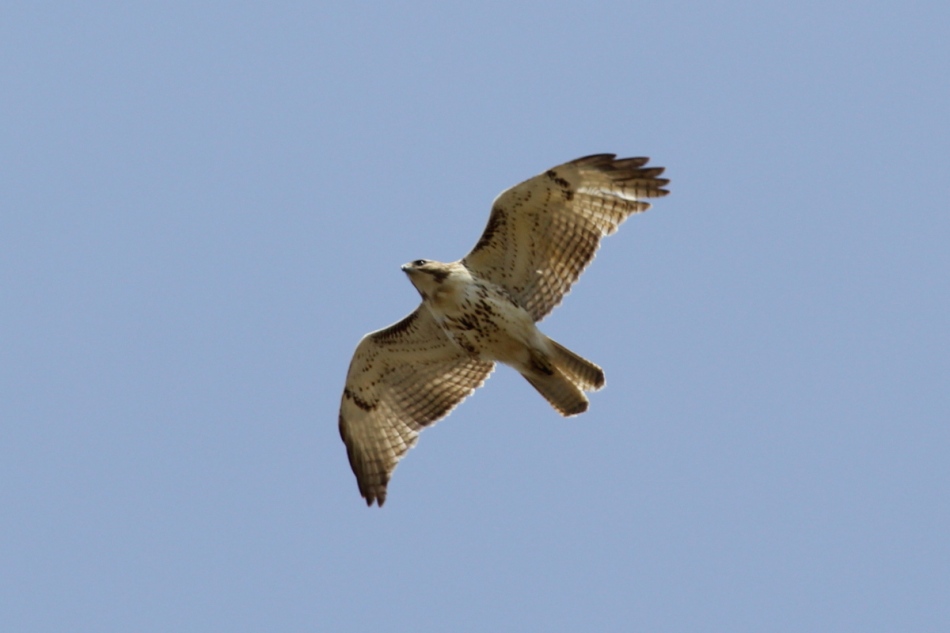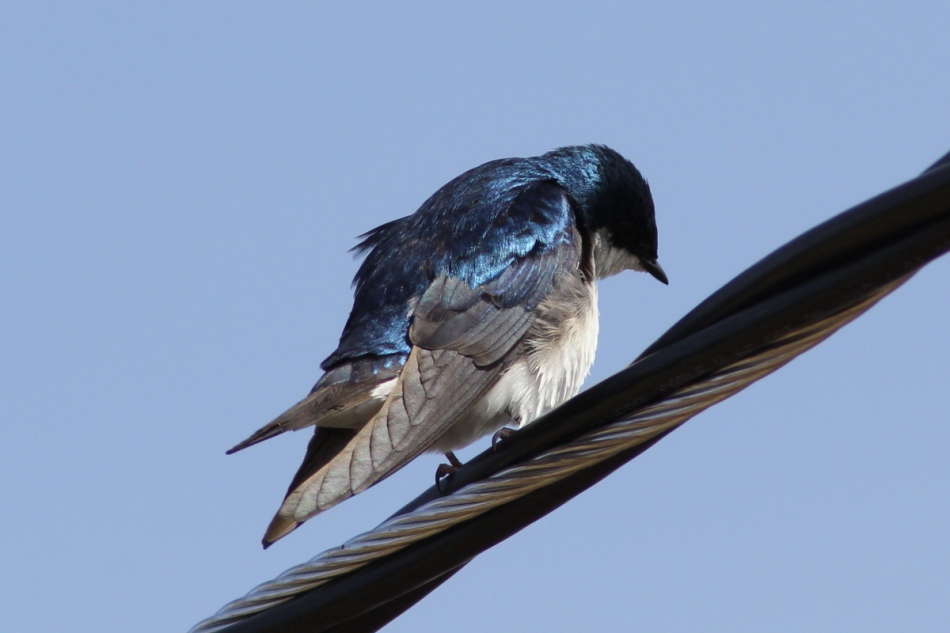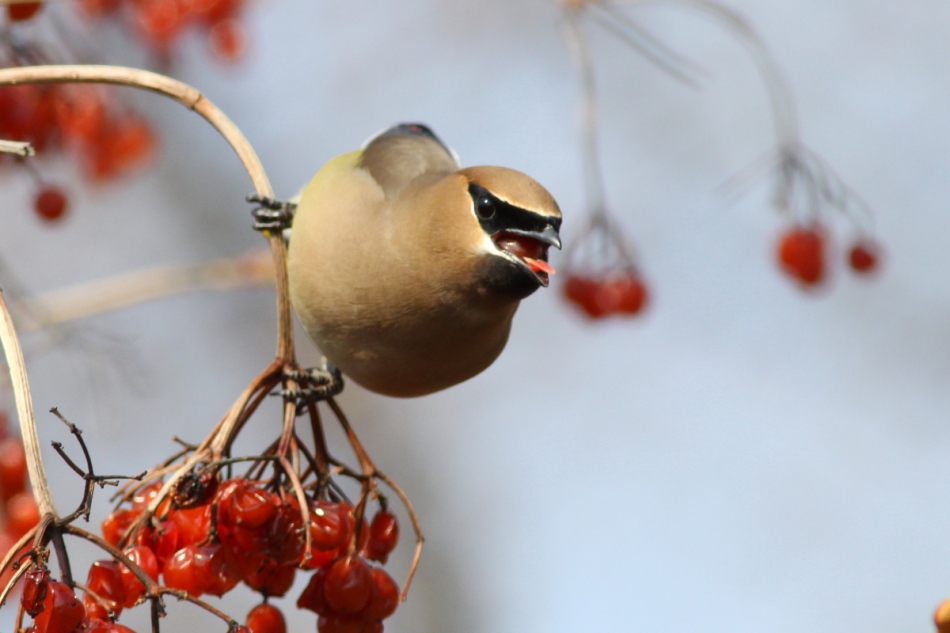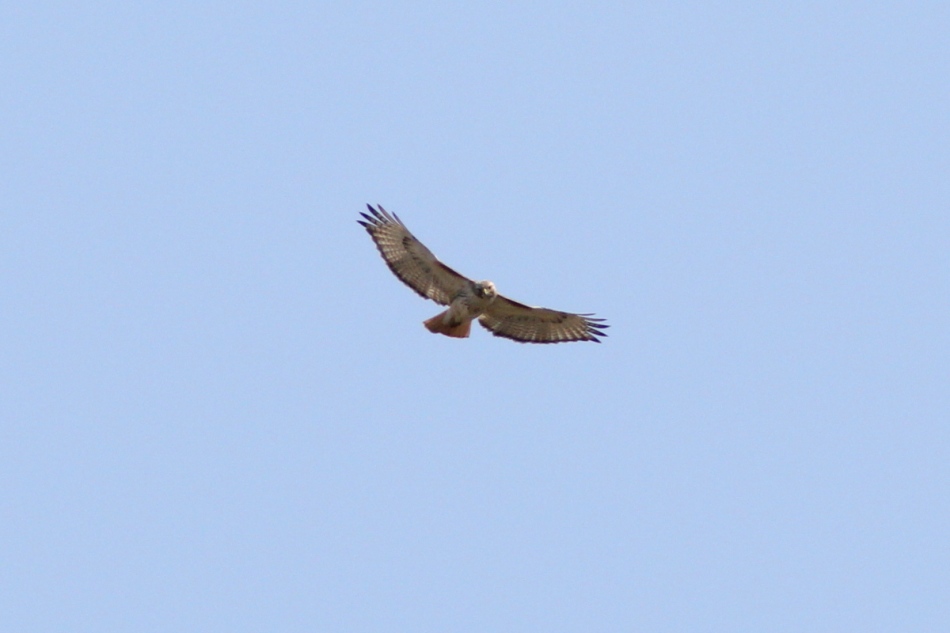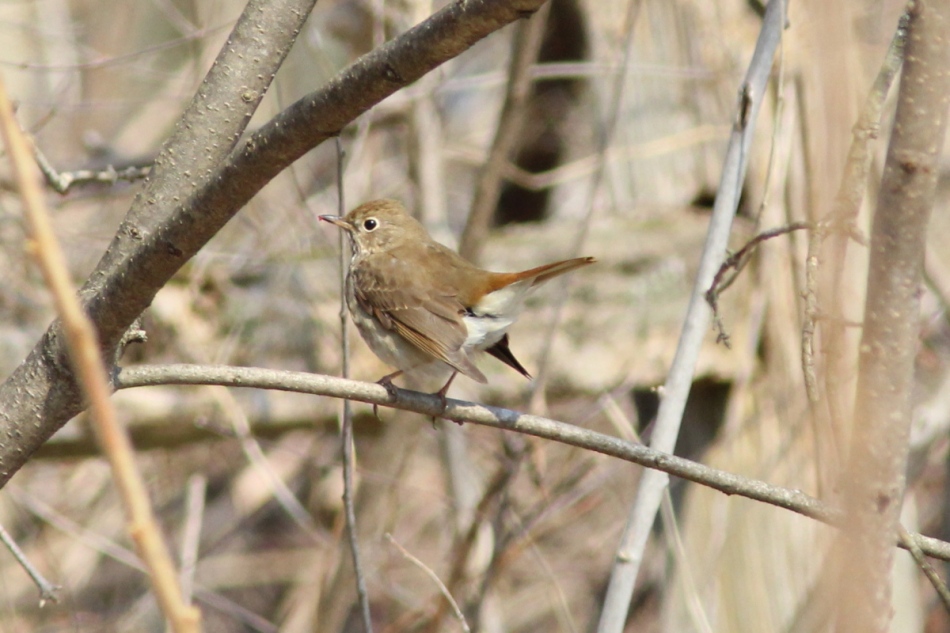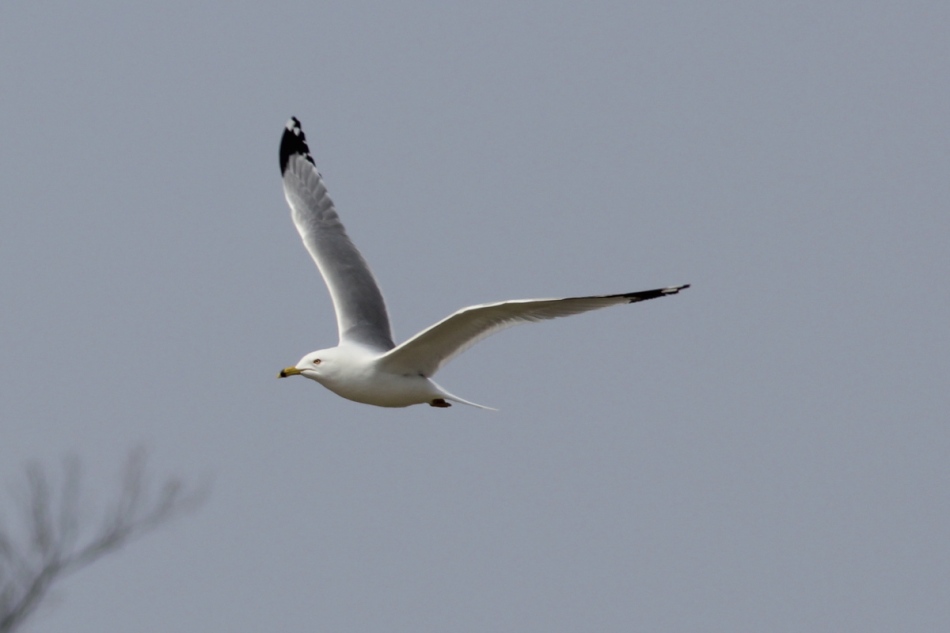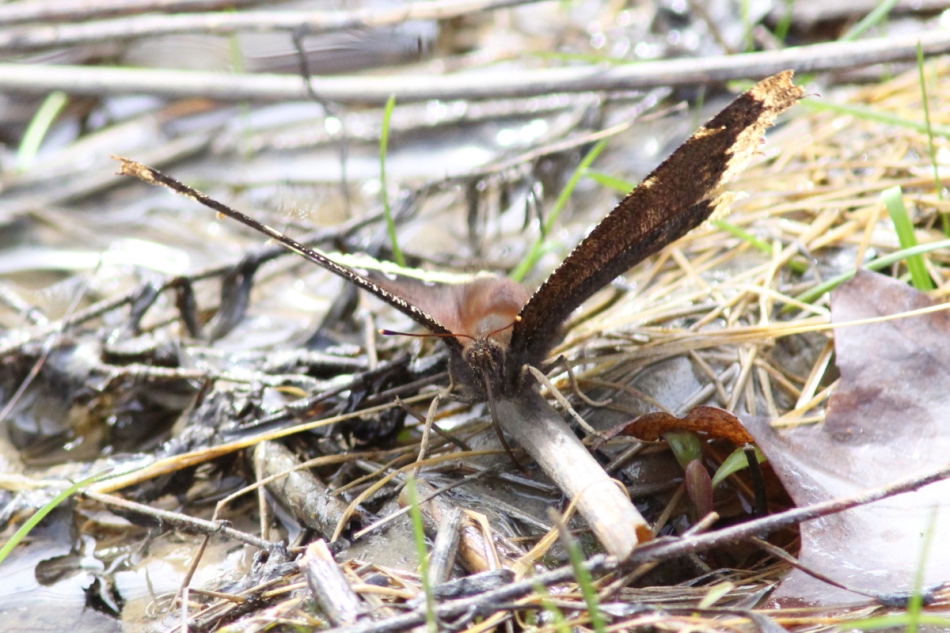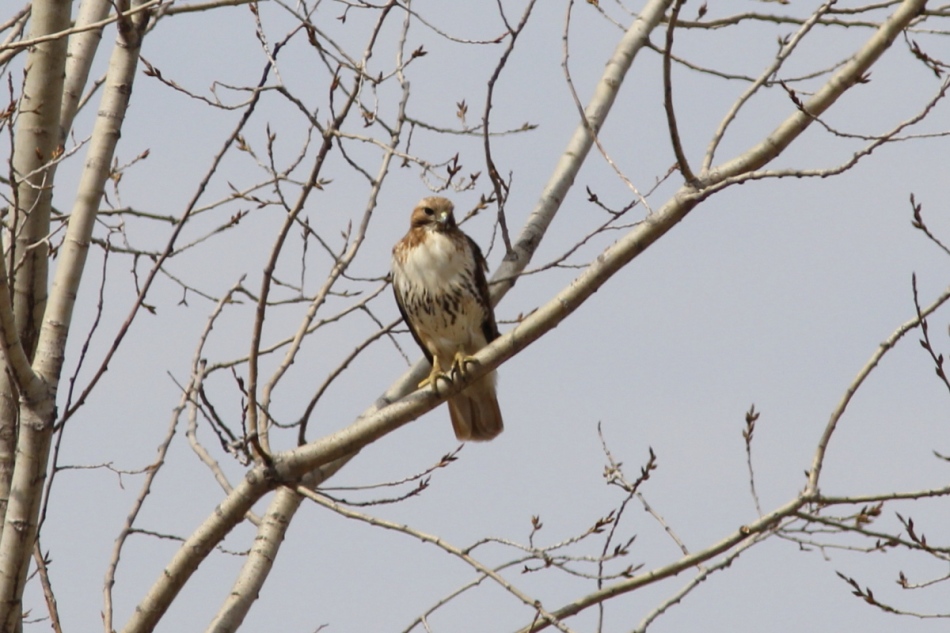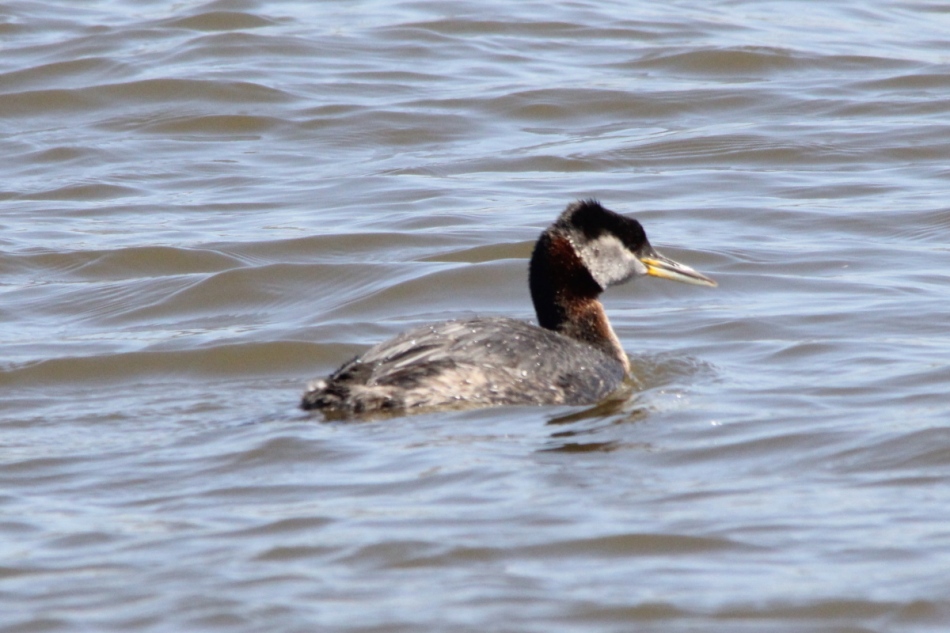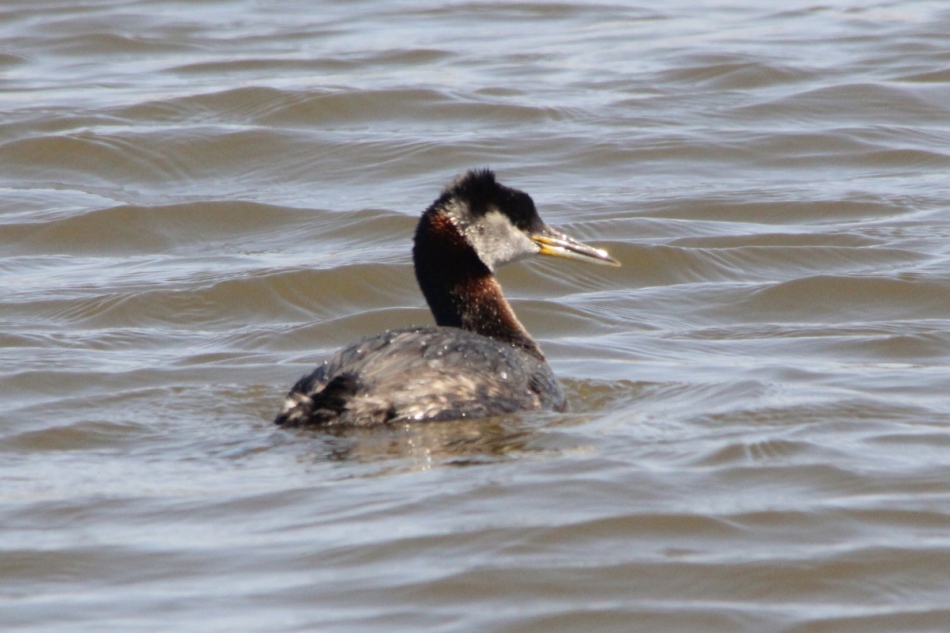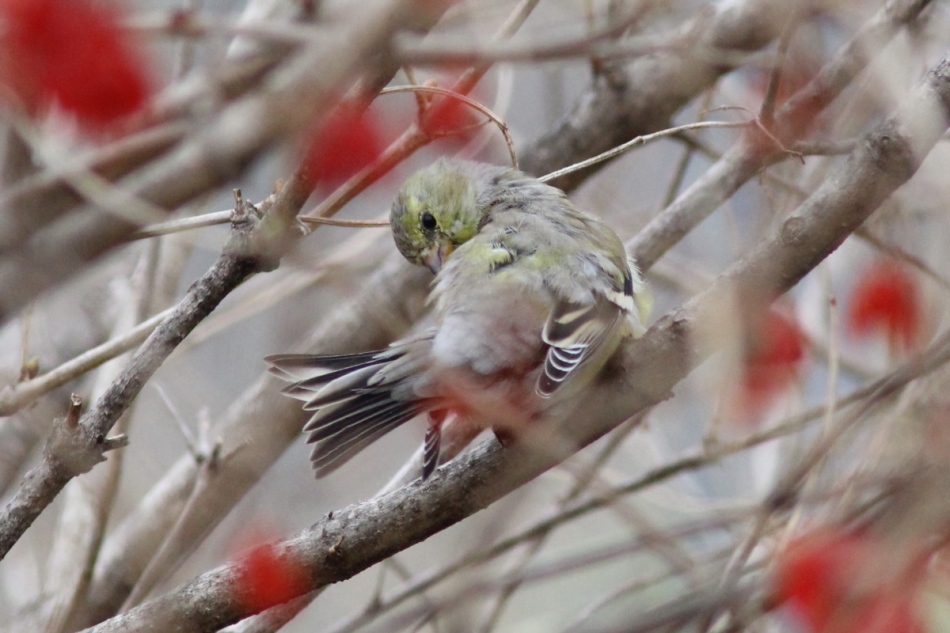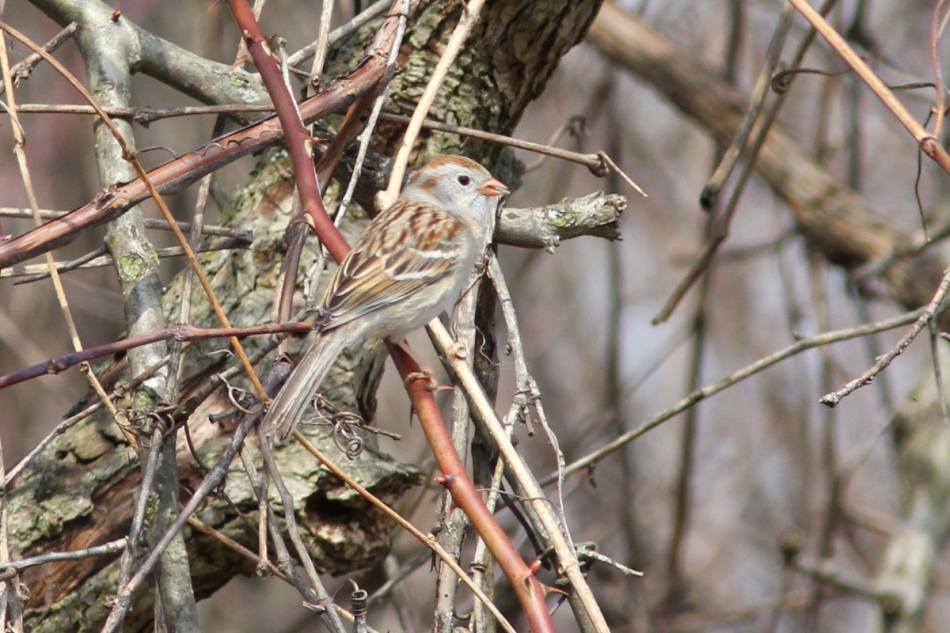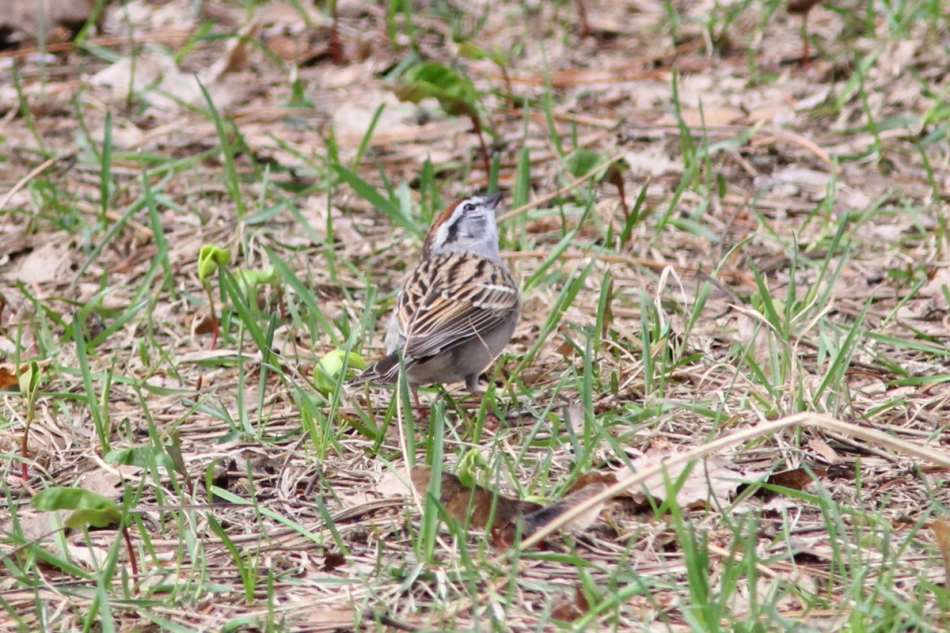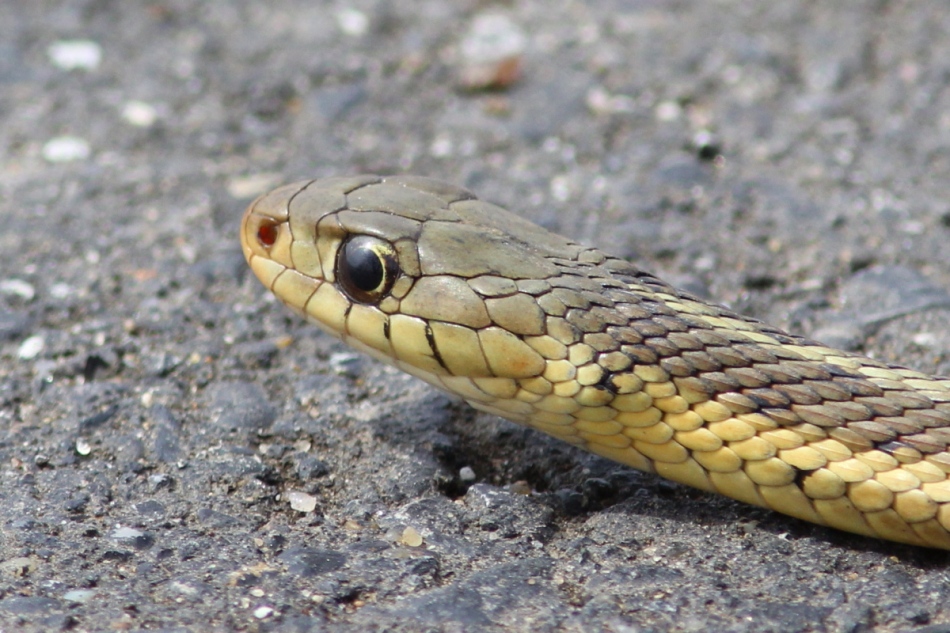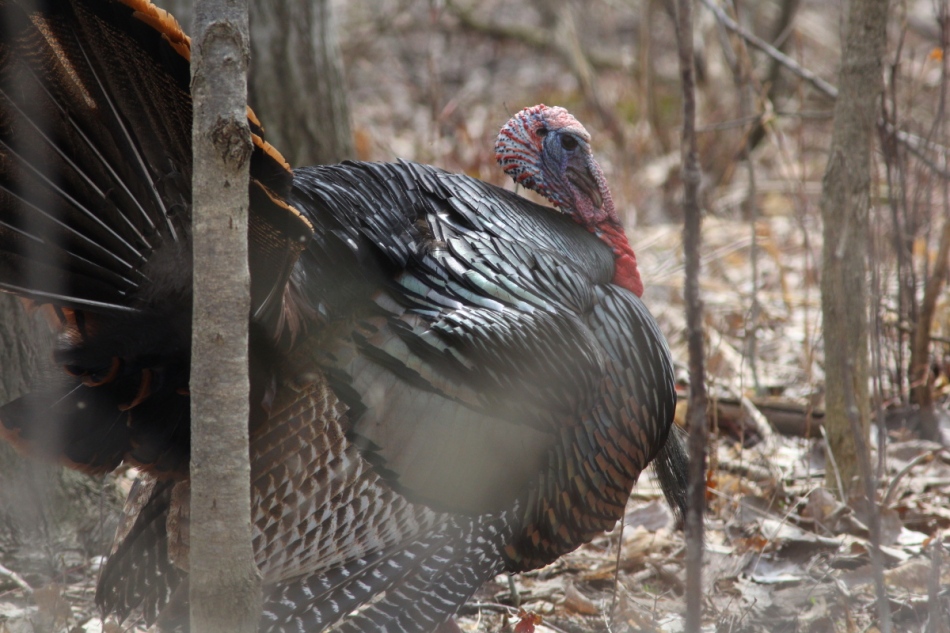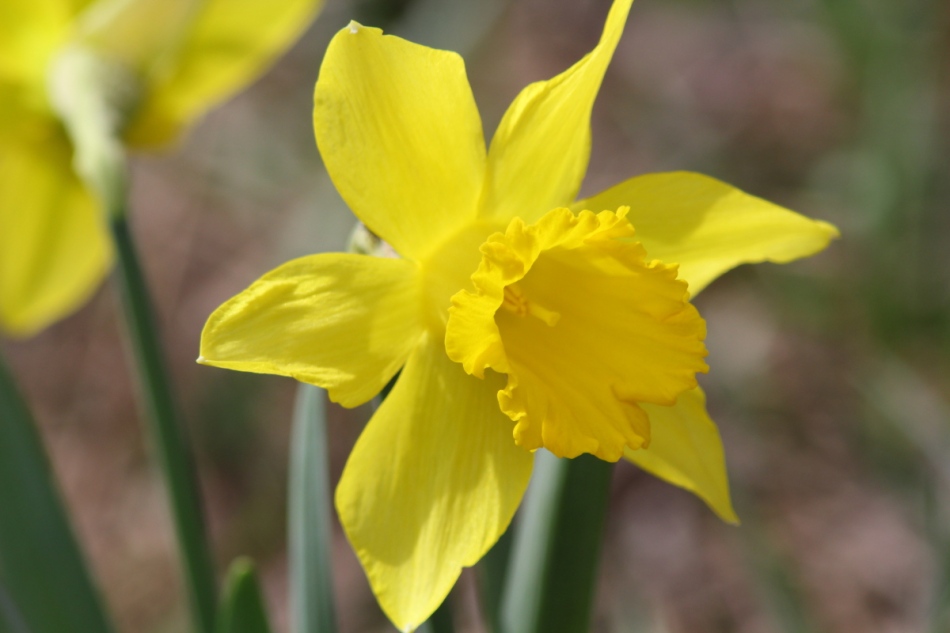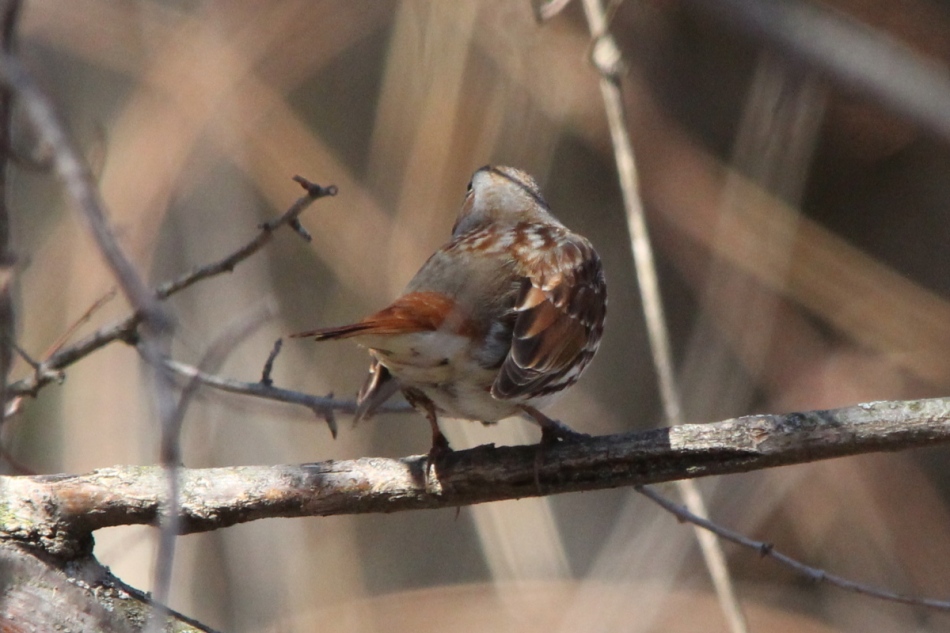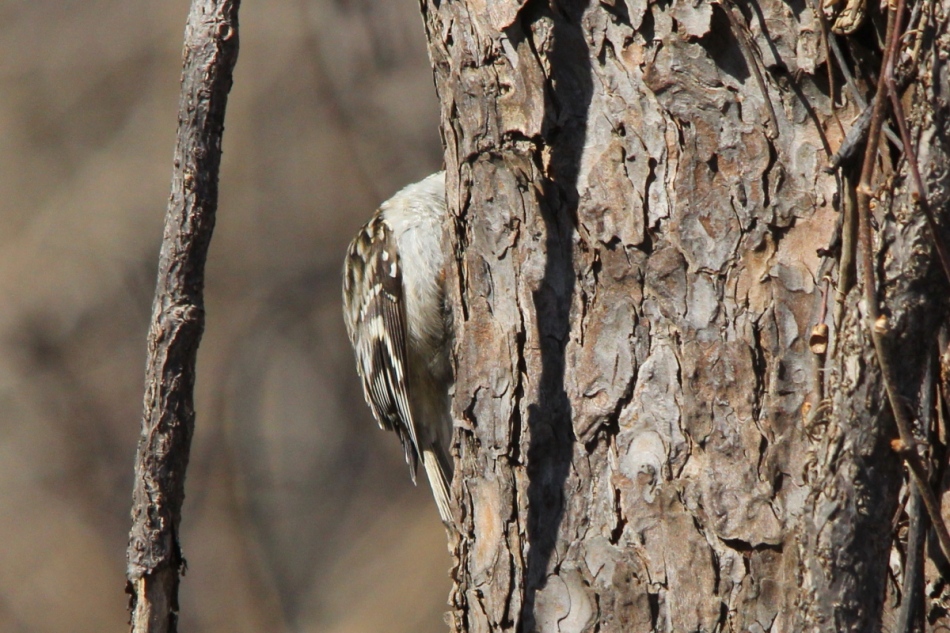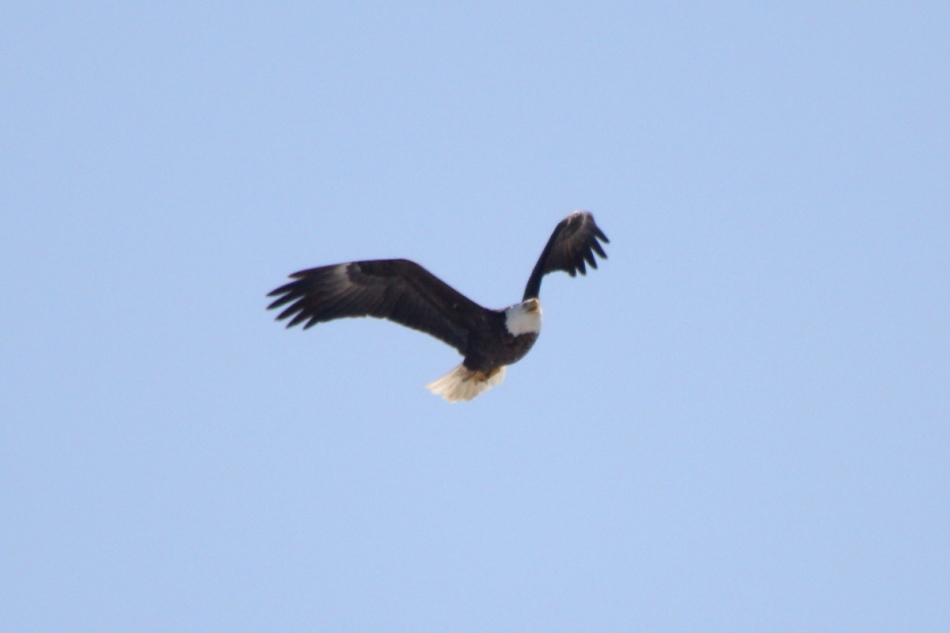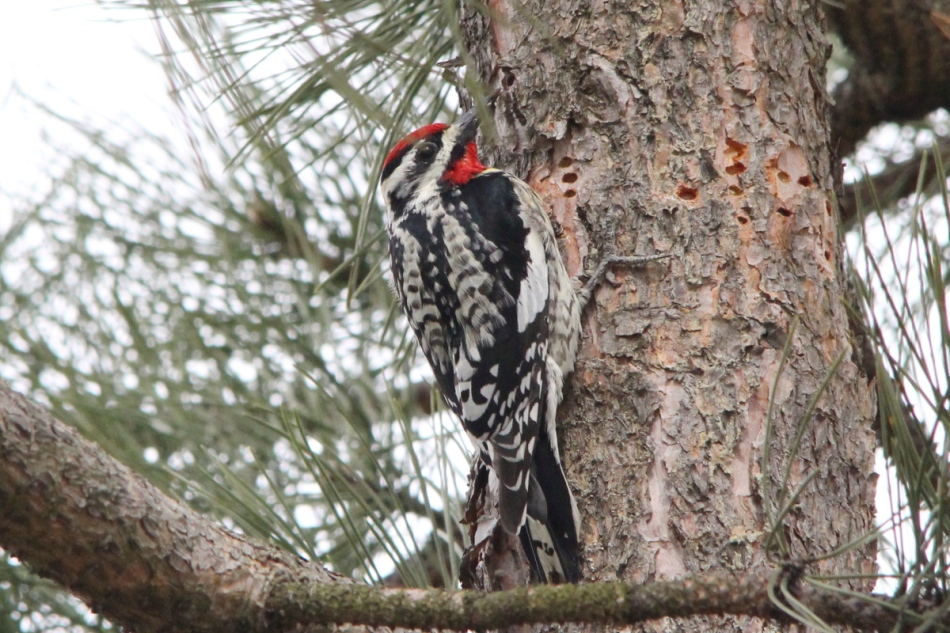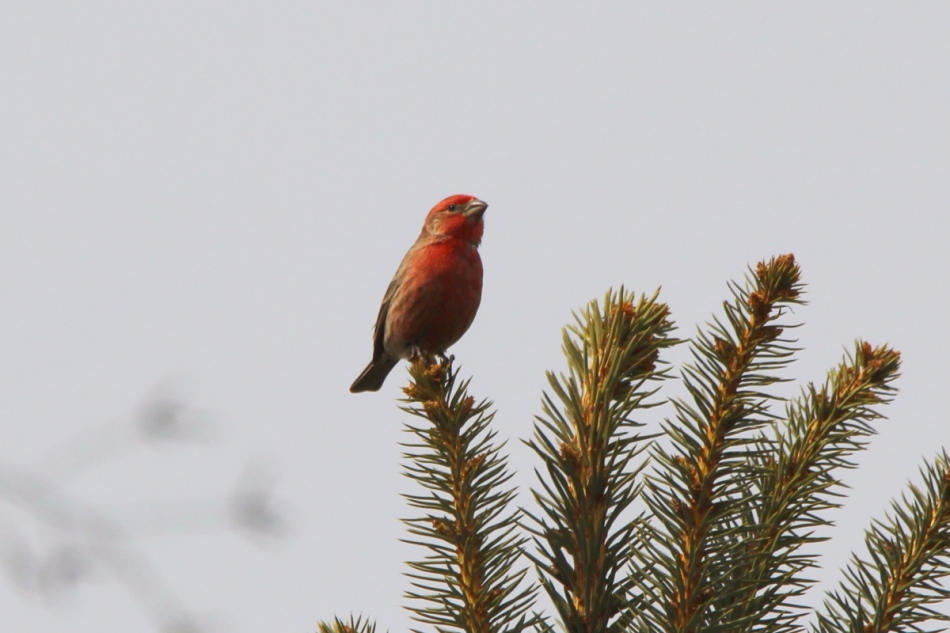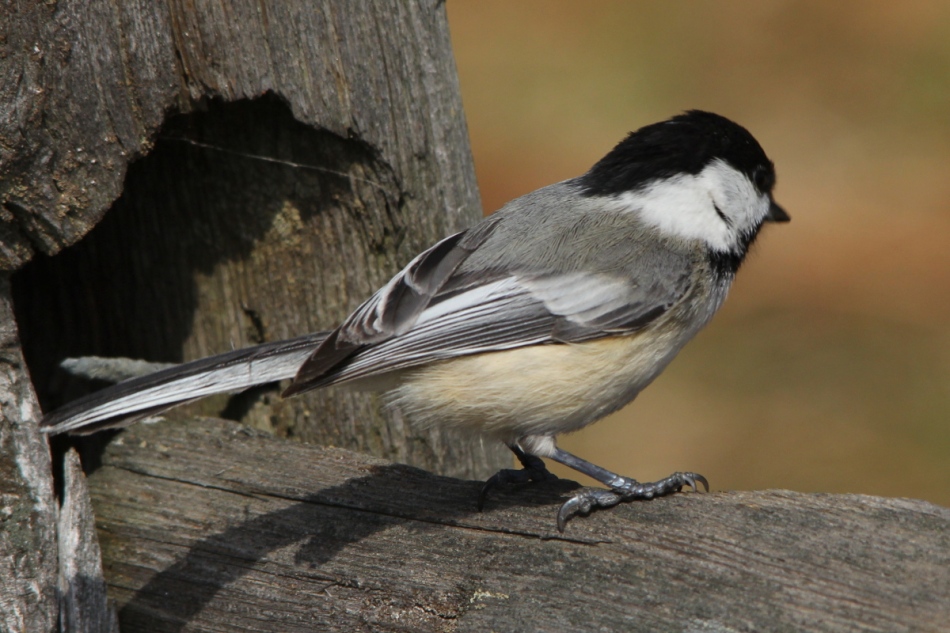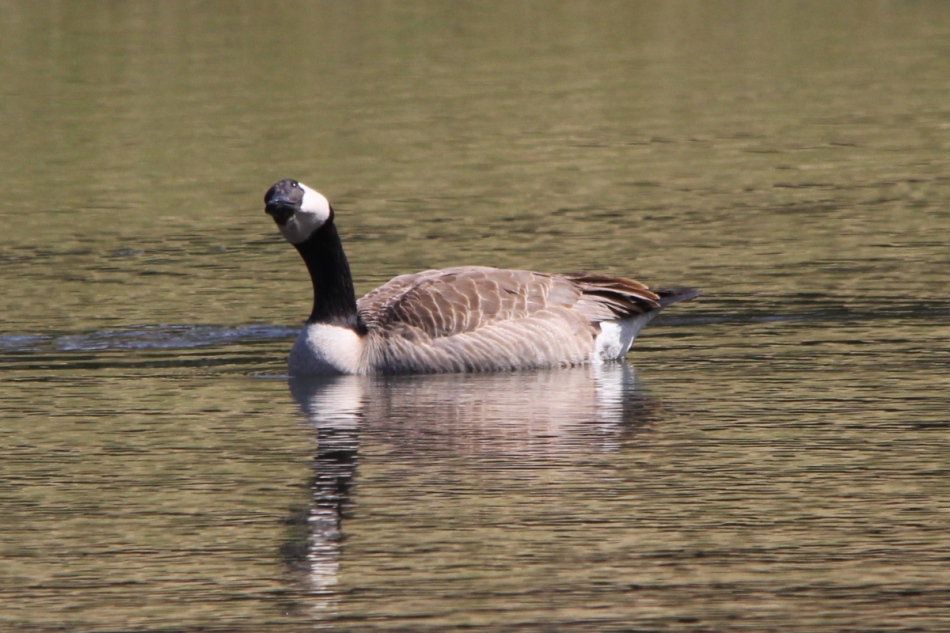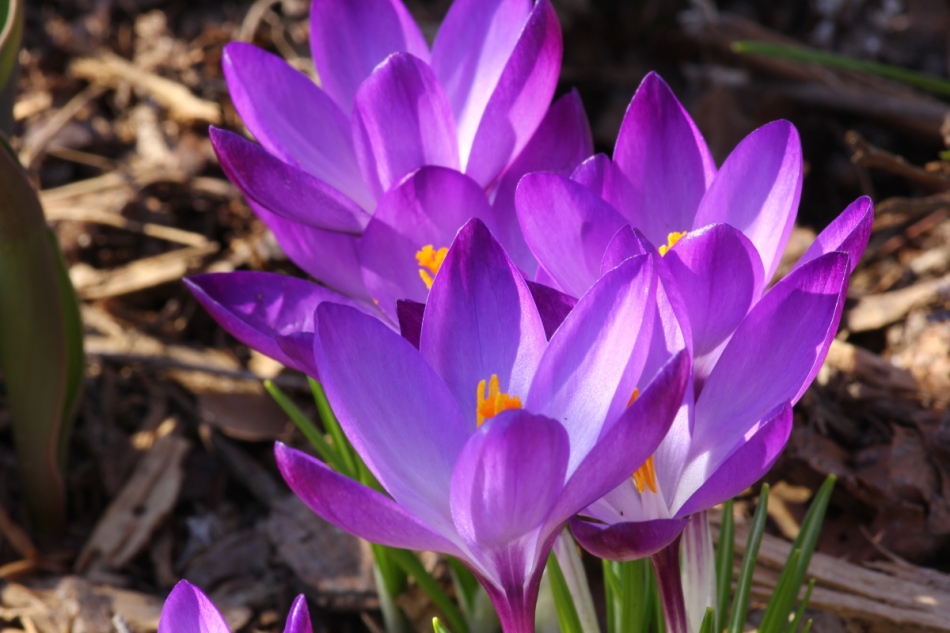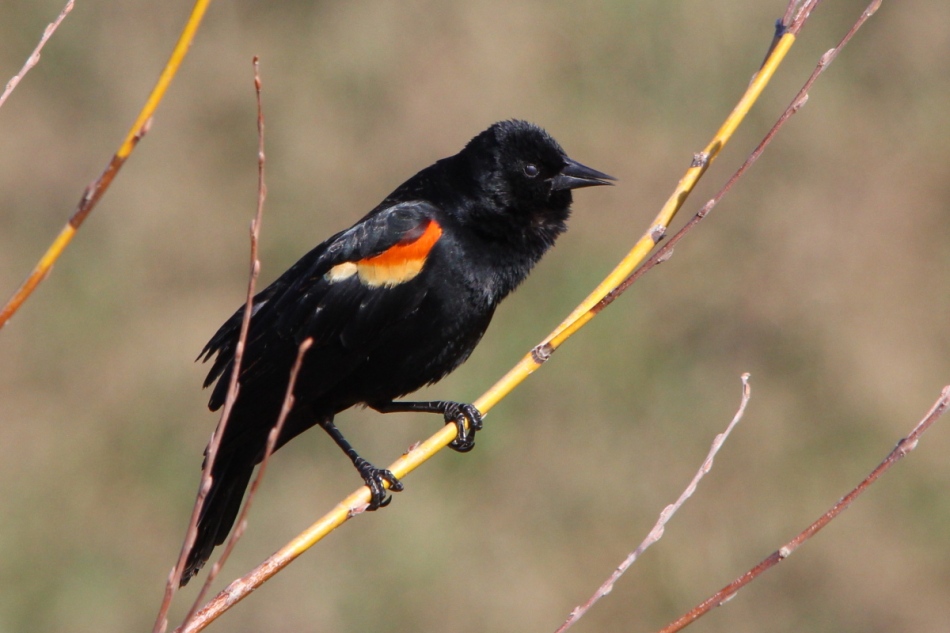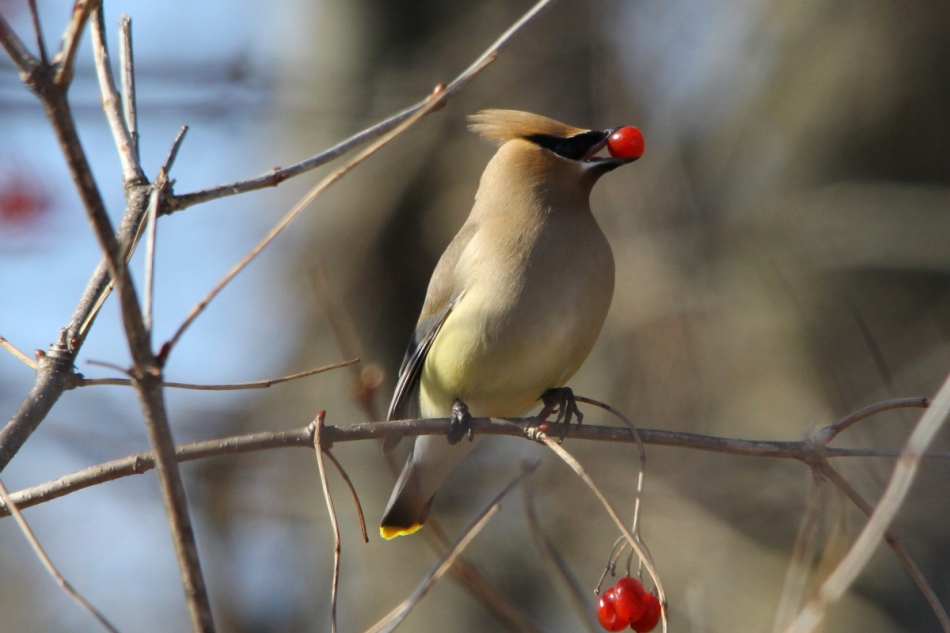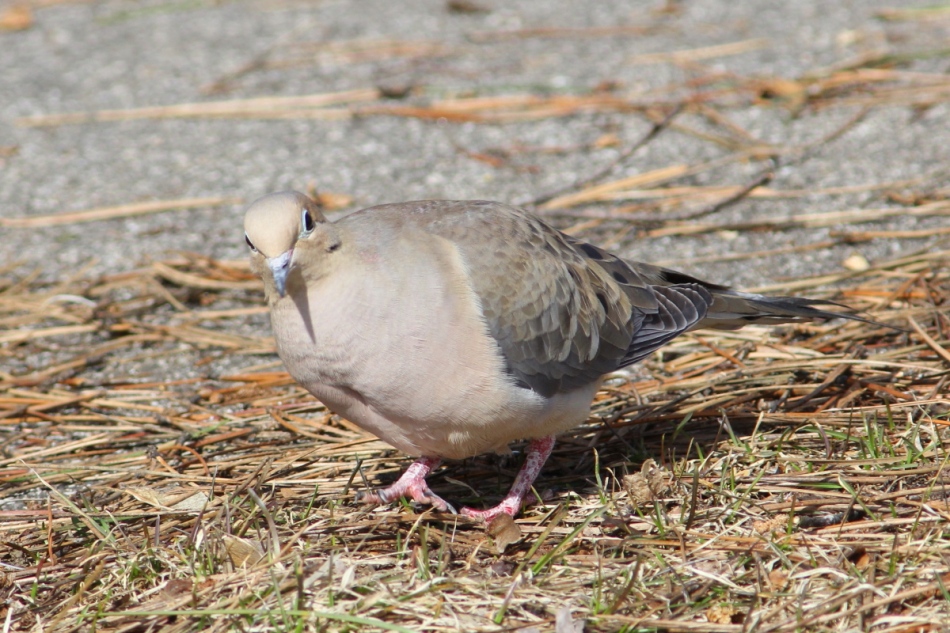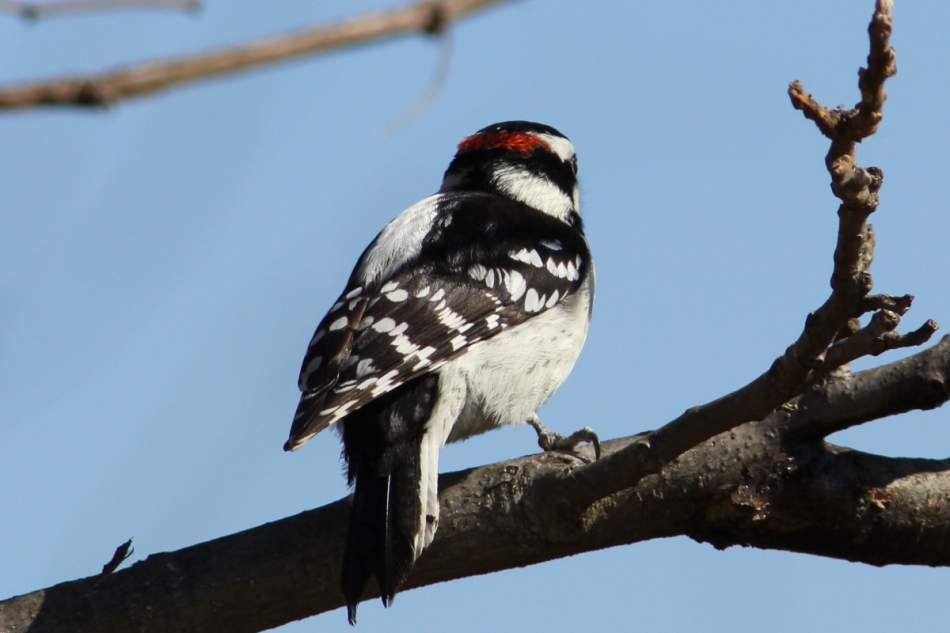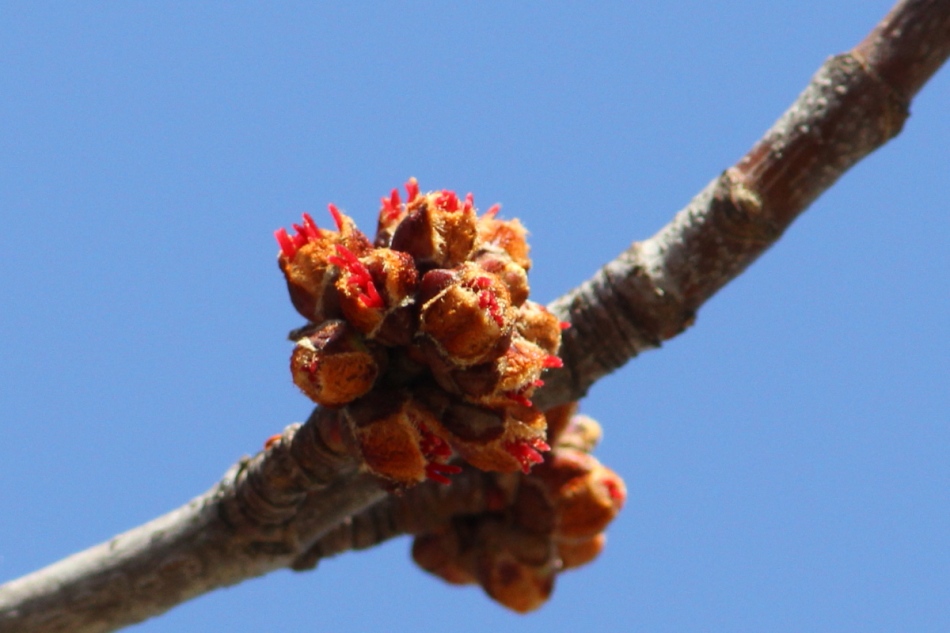A disappointing day
I went to Aman Park today, hoping to catch the trillium bloom at its peak, no such luck! I think that the weather had a lot to do with it. It was raining a little as I left home, and the rain continued until I had almost reached the park. The clouds held on until mid-afternoon, and it was very windy the entire time.
It’s probably just as well that I didn’t find many flowers to photograph, as I would have gotten extremely frustrated by the wind if I had tried to use my macro lens and tripod. I had a hard enough time shooting handheld at high ISO.
But, when I got to the park, I wasn’t sure what I would find. Most of the flowers are down in a valley along Sand Creek, and I was hoping that the wind wouldn’t be as much of a problem in the shelter of the bluffs above the creek. So, I loaded everything up and set off down the trail. The farther I went, the worse it looked as far as no flowers open, and sure enough, I got down to where the trillium are present in huge numbers, and all I could see were buds. I wandered around a little and had a difficult time finding any flowers that were open of any species. I can’t say for sure, but it looks like almost all of the early spring flowers close up at night and open in sunshine, as I couldn’t even find spring beauties or trout lily open, and they’ve been blooming for almost two weeks.
So, I turned around, went back to my vehicle, and put the second body, macro lens, and tripod back in it, then set off the other direction to look for birds.
I didn’t have much luck with birds either, other than a few bad photos of the same species as what I saw yesterday at Palmer Park, which I still need to do a post on.
And, that reminds me, because of an error on my part, most of you didn’t receive a notice about this post that I finished on Saturday, if you’re interested, you may follow the link if you choose to do so. It includes photos like this one.
Since the weather wasn’t nearly as good today as it was yesterday, here’s the best that I could do.
The last two look exactly the same here, but there’s 1/3 stop of exposure compensation difference between the two. I should learn that such minor differences don’t show up here, although they do on my computer.
I played peek-a-boo with a downy woodpecker.
As the day wore on, more sunlight began to appear, and a few trillium opened up.
I watched water striders mating, it’s that time of the year!
And here’s a few more odds and ends.
I’m not sure, but I think that the chickadee felt sorry for me. He posed for some time, so I shot many photos, but since I have posted so many lately, just this one will do for this post.
I’ve been trying to learn the names of the flowers, but here’s a few that I have yet to learn.
That’s it for the images from today. After yesterday’s birding bonanza, today was a little disappointing, but it turned out to be a nice day to be outdoors, even if I didn’t get the images that I had planned on.
I have 70 left from yesterday when I had one of my best days ever as far as photography. I was going to put them into a post of their own, but looking at the weather forecast for this coming week, I think that I’ll wait for a day or two to decide what to do with those photos. It’s forecast to rain everyday this week, with lots of wind, so photos may be few and far between this week. Maybe I’ll use the images from yesterday spread out over the next week.
And, to wind this up, it looks as if I’ll be going back to Aman Park next week in hopes of catching the trillium at their peak. I’ve hit it the last three years, I don’t want to break the string.
That’s it for this one, thanks for stopping by!
Baird’s Sandpiper, Calidris bairdii
Note: this post, while published, is a work in progress, as are all posts in this series, My Photo Life List. My goal is to photograph every species of bird that is seen on a regular basis here in Michigan, working from a list compiled by the Michigan chapter of the Audubon Society. This will be a lifelong project, that I began in January of 2013, and as I shoot better photos of this, or any other species, I will update the post for that species with better photos when I can. While this series is not intended to be a field guide per se, my minimum standard for the photos in this series is that one has to be able to make a positive identification of the species in my photos. The information posted here is from either my observations or the Wikipedia, the online free encyclopedia, however, I have personally shot all the photos appearing in this series.
Baird’s Sandpiper, Calidris bairdii
The Baird’s Sandpiper is a small shorebird.
Adults have black legs and a short thin dark bill. They are dark brown on top and mainly white underneath with a black patch on the rump. The head and breast are light brown with dark streaks. In winter plumage, this species is paler brownish gray above. This bird can be difficult to distinguish from other similar tiny shorebirds; these are known collectively as “peeps” or “stints”.
One of the best identification features is the long wings, which extend beyond the tail when the bird is on the ground. Only the White-rumped Sandpiper also shows this, and that bird can be distinguished by the feature from which it gets its name.
Their breeding habitat is the northern tundra from eastern Siberia to western Greenland. They nest on the ground, usually in dry locations with low vegetation.
They are a long distance migrant, wintering in South America. This species is a rare vagrant to western Europe.
These birds forage by moving about mudflats, picking up food by sight. They mainly eat insects, also some small crustaceans.
This bird was named after Spencer Fullerton Baird, a 19th century naturalist.
On to my photos:
This is number 154 in my photo life list, only 196 to go!
That’s it for this one, thanks for stopping by!
My Week, one step back?
Monday
After about a perfect weekend, the weather is forecast to go downhill for the rest of the week, starting this evening. In a way, that’s okay, it was really too warm for me too soon yesterday afternoon, the warmest day since October 12th. The forecast for the rest of the week is for cooler weather, which suits me just fine. We could use some rain, and may get a little overnight. That would go a long way towards helping things green up around here.
I wore myself to a frazzle yesterday, I can feel it in my bones today, but that’s okay, it’s a good kind of tired. You’d think that since I walk two to three miles everyday all winter long that I wouldn’t need time to get into shape for longer hikes in the spring, but I guess that old age is catching up to me.
I can see that the new 300 mm prime lens is going to play into my naturally lazy streak, it’s so easy to carry compared to the Beast (Sigma 150-500 mm lens) and it does near macros almost as good as the Tokina macro lens. But, almost isn’t good enough, I know that next weekend, when I go to Aman Park for the wildflowers, I’ll be using the Tokina lens on the second camera body, and have it mounted on the tripod as it should be.
It kind of surprises me that I haven’t been seeing any early spring warblers migrating through the area, but they will come, eventually. I should be tracking them on eBird, but haven’t found the time to do so.
I’m back from my walk, but I don’t have time right now to work on this, so I’ll have to do it tonight after work.
I didn’t have time to work on this last night either, so now it’s Tuesday morning, so I’ll just dump the photos from yesterday in here and move on.
I suppose that a few quick words are in order. I’m trying to shoot more flower photos in anticipation of this next weekend when I’ll spend a day in Aman Park photographing even more flowers. I’m trying to get the few species that grow around here “done” so that there won’t be far too many for me to choose from then.
I know that I have posted a few images of the maple flowers, but this is my best so far. I hate to keep working my way up to a really good one, but I never know that’s what going to happen. I could hold off and wait to see if I get better photos, but that doesn’t always happen before the flowers fade, as was the case with the crocus earlier this spring.
I included the blue jay, because it is a male that had just given its mate a bit of food, which is common practice in some species of birds. Two summers ago, I posted photos of a male cedar waxwing giving his mate berries. That behavior is quite understandable in the bird world, as how well that the male is able to provide food for the female on the nest and/or the young birds when they hatch is very important. But, what does that say about human females and their desire to receive gifts from their mate? 😉
Tuesday
Since I’m running behind, just a quick weather report. After some much-needed rain overnight, it’s sunny, but much cooler than it has been the last three days. The forecast for the rest of the week is now for continued cool, even cold weather into next week. Today will be 25 degrees cooler than yesterday, somewhere in the middle would be nice.
I’m back from my walk, and I have decided that it’s time for me to make some decisions, about a number of things.
For one thing, I’m thinking of driving to the park in the morning at least until after my vacation is over. I’m trying to take it easy on my legs by not carrying anything more than just the new lens, but that isn’t helping much, especially since I have been spending the majority of the days on weekends outdoors for the past few weeks. I purchased the Tokina macro lens to get photos of small flowers, but because I’m trying to go easy on my legs, I haven’t been carrying it, and if I don’t have it, I can’t use it.
I started today by taking photos of small flowers that I knew wouldn’t be what I wanted for my blog, well, I could post them, but then, I’d kick myself for not doing things the right way. The flowers are beautiful, but tiny, and they wouldn’t show up well here. I need to use the macro lens mounted on the tripod to get the photos that I would like.
On top of that, the small woodlot at the corner of the apartment complex is being cleared, I believe that there’s going to be a storage facility built on that property. That woodlot was one of the few spots on the walk to and from the park that I would shoot any photos. With the woodlot gone, there’s not much reason for me to walk along the road a mile in each direction other than for the exercise, and right now, my legs need rest, not exercise.
You see, this all started as I thought about how many photos of the maple flowers that I shot, and the few that I posted, before finally getting a good one, the one in this post. I could hold off posting any photos of a subject until I did get a good one, but a much better plan would be to get a good one on my first attempt. I know how, but I get lazy, or come up with an excuse such as it is too windy to bother taking the time to do it right. Well, I should either do it right or not at all.
So today, after taking photos of the tiny flowers that I won’t post, each time I photographed something, I asked myself “Is that the best you can do?”. Most of the time, the answer was no.
Here’s a series of images as an example. I noticed the cedar waxwings in a pine tree, and shot this first photo.
But that one was not alone, there was a small flock of them in the tree, many of them huddled together.
I started to walk away, then I asked myself if I could do better, and the answer was of course, so I went back, stopped down the aperture for more depth of field, and shot this one.
It may not appear that there is much difference between the two photos here, but full screen, there’s a huge difference, the waxwings are all entirely in focus in the second photo, while some of them are a bit blurry in the first.
Hopefully, I’ll continue to ask myself that all important question with each photo that I shoot, so that I can post fewer, but better photos, like these two.
But, despite my new attitude, there will be times when I have to shoot fast, at least until going for the highest possible quality becomes second nature. Here’s an example from today.
I had seen an eastern phoebe in the distance, and was working toward it, and a few other birds, when the phoebe landed on a branch where I had a fairly good view of it, and it had a beetle in its beak.
The phoebe smashed the beetle into the branch repeatedly to kill the beetle.
Then turned the beetle so that it could be swallowed head first.
Then, it was down the hatch!
After it was all over, I had time to fine tune the focus for this photo.
Again, there may not seem to be much difference in the photos here, but there sure is full screen! But, I didn’t want to take a chance on missing the action by playing with the focus as the phoebe was eating.
Wednesday
I’m finally getting caught up, I could use a few more hours in every day lately.
I have given the idea of driving to the park at least some days more thought, and I think that today, I will drive. Yesterday wouldn’t have been a good day for macro photos, as the wind was quite strong, and even the shortest of plants were swaying in the wind. So, I think that until after I get back from vacation, what I’ll do is to check the weather forecast, if it looks good for macro photography, I’ll drive to the park. If it doesn’t look good, with either clouds or wind, then I’ll do the full walk instead of driving.
Driving to the park will not only save me wear and tear on my legs, but also “wasted” time, the time it takes me to walk to and from the park each day. One thing that I’ve learned is that good macro photos takes time to get the set-up correct, or I’m better off not bothering to try them.
The alternative would be to try to alternate what I try to photograph each day. Bring one of the long lenses one day, then the macro lens and tripod the next, and do that repeatedly. The problem with that is that I would miss photos like the one of the phoebe eating the beetle, or a migrating species of bird. Besides, there are times when the new 300 mm lens would be the right lens to use on the tripod for near macro photos.
I can carry all my stuff, I’ve done it, in fact, for a week, I did just that. But, strapping an extra ten pounds of photo gear to myself doesn’t help my legs to recover. I’d rather not start my vacation with tired, worn out legs, even though I do plan on spending some of my time just relaxing for a change.
Anyway, enough whining, time for food and photos.
Well, I’m back, and I’m disappointed. I did drive to the park, and I discovered a few benefits to doing so, the major one is that I’m not walking two miles on pavement. I’ll bet that I walked almost as far today as I do on a typical day starting from home, but today, since I walked on ground rather than the sidewalk, my legs feel fine. I was gone longer than I normally am, and did two and a half laps around the park.
Also, on a day like today, when it started out frosty, but warmed up quickly, I could throw the clothes that I shed into my vehicle, and not have to carry them around along with my photo gear.
My disappointment is from my macro photos, there were some fair ones, I’ll post one or two, but I’m finding good macro photos are tricky. If every bad photo is a learning experience, I learned a lot today! Like, if I’m standing on squishy ground, I had better not move while the camera shutter is open, not even to breathe! And, that’s with the camera mounted on the tripod. Also, if a small flower looks like it is vibrating slightly in the wind as I look through the viewfinder, it is, and any photos I shoot at 1/10 of a second for a shutter speed are not going to be as sharp as I want them.
So, here’s my photos from today, starting with an old stand-by, a male cardinal singing with a shadow across its face.
I know that I have posted quite a few photos of red-tailed hawks in flight, but here’s two more, first is Bruiser, the second is his mate, Bertha.
The reason that I posted those is that I’m beginning to think that when they spot me, they fly over me to check me out. Bruiser normally circles me at a short distance away, Bertha flies directly over me, at low altitude.
Now then, for my two macro photos, and the first barely qualifies.
The reason for the second one, even though it is crap is due to the size of both the flower and the bug. The flower was about 1/4 of an inch in diameter, I couldn’t see the bug without my reading glasses on, it was that tiny. That was shot with the Tokina 100 mm macro lens and the Tamron 1.4 X extender behind it. I should have bumped the ISO up from 100 to get a faster shutter speed so that the wind wouldn’t have ruined that photo.
I suppose that the good news is that the combination of the Tokina 100 mm macro lens and the Tamron 1.4 X extender will allow me to photograph even the tiniest of flowers, once I get the hang of it.
Wait, I have one more macro photo worth posting.
That was taken using just the macro lens without the extender, and it is also where I learned that I have to be still while the shutter is open, even with the camera on the tripod. I had the camera set to lock-up the mirror, and to use the two second self timer delay so I thought that the camera would be steady while the shutter was open. I would press the shutter release, then step back to make sure that I didn’t bump the camera, but the ground was so squishy that my stepping back caused the tripod to move. Silly me! It wasn’t until I noticed that both the tripod and my feet were sinking in the mud that I figured out why I couldn’t get a sharp photo.
That’s all for today.
Thursday
Cloudy, mild, and breezy this morning, with the chance of a few sprinkles of rain, so I won’t be trying any macro photography today. I have to say this about the week so far, despite the dire weather forecasts for this week, in reality, it has been quite pleasant. I hope that the meteorologists are just as wrong about next week as they were about this one! They are predicting temperatures in the 40’s next week, with quite a bit of rain, but that’s what they were originally forecasting for this week, but it turned out to be seasonably cool with just a little rain, we could use more.
The weather forecast for this weekend are looking good for a trip to Aman Park for the spring flowers. Hopefully, I’ll put what I learned yesterday to good use and come back with images worth posting.
It really surprised me yesterday as far as how good my legs felt after my walk, since I avoided walking on pavement by driving to the park, rather than walking. But, since I’m not going to be lugging all my gear today, I’m going to walk to the park, but avoid the pavement and walk in the grass whenever I can to see if that helps.
I did get a couple of photos of a mourning cloak butterfly yesterday, but I’m not going to post them, as I missed the exposure slightly. But, I should say that the new 300 mm lens is great for insects that size! I was able to stay back from the butterfly far enough not to spook it, yet nearly fill the frame with it. The images would have been great, if I hadn’t over-exposed them a little.
Time to get going.
What an odd day! It did sprinkle lightly most of the time while I was outside, but that’s usually good weather for seeing birds if not photographing them. But today, I saw very few birds at all. It was too cool for butterflies, and too cloudy for any of the spring flowers to have opened for the day.
So, to get it over with, my two photos from the day, one is fair, the other is crap.
The only reason for posting the thrasher is because he was singing away like crazy today. And, isn’t that the way it goes, on nice sunny days, they stay low and hidden in the thickest of brush, on a cloudy, rainy day, he perches right out in the open to sing, as if he knows that I can’t get a good photo of him on such a day. No matter what, it is a joy to hear him in full song!
My vacation starts two weeks from Saturday, and I’m beginning to get a little concerned about the conditions that I’ll have. There’s still snow on the ground in some of the wooded areas, and some of the lakes are still frozen over. Well, I suppose that I could look on the bright side of things, at least there won’t be any skeeters or black flies!
I need to pick up a couple of items before I go, a fishing license, a new duffel bag, and something to store water in. I’m planning on doing at least some camping out in the woods, not in a campground, so I need to be able to pack water. Other than that, I’m set other than packing everything up and into my Forester. Oh yeah, I’ll need to go to the bank for some cash, as the Michigan DNR doesn’t accept debit cards at the campgrounds that I do stay in.
If worst comes to worst as far as weather, I can combine some day trips from home with as much time up north as the weather allows. That, or I could work my way north as conditions improve. We’ll see, there’s still two weeks to go.
I think that it’s time to start a check list to make sure that I don’t forget anything.
Friday
I’ve been fooling around some waiting for the overnight rain to clear out this morning before I go for my walk today. It will be cloudy when I do head out, and I’d call the temperature seasonable for the end of April.
I’ve started my shopping list of things that I need for my vacation, and have added a few small items such as spare lantern mantles, I think that I used my last one last fall. Better safe than sorry! When I go grocery shopping this weekend, I can buy the food that I’ll be taking on vacation that can be frozen, so I’ll have that done and out of the way.
Over the next week, I’ll get all my gear sorted and ready to pack, it will be the busy time of anticipation before the big event really gets here, and I’m so looking forward to two full weeks away from work and being out in the woods all day, every day!
Well, enough of that, time to get moving.
I’m back, and let me change the weather report slightly. It was cloudy, but it was unseasonably cool, even though there was no wind until I was almost finished with my walk. I could see my breath most of the time.
Other than it being cooler today, the weather was much the same as yesterday. Then, there were very few birds around, today, they were all over the place.
The weather the past two days has exposed a weakness in the new lens and extender, that combination is never fast to auto-focus, and the past two days, I’ve missed more shots than I’ve gotten due to how slow that the combination is in low light. I’ve noticed the same thing before, and even in good light, they are slow to auto-focus. I was able to get a few good flying bird images this past weekend, but there were several times that I considered removing the extender and just using the new lens by itself.
I don’t think that I have tried this replacement lens without the extender, I really should. The lens that failed was much quicker to auto-focus without the extender than with it.
Or, I could take the Beast, which is much better at getting the birds, however, it can’t do this as well as the new lens.
If I limited myself to just birds as subjects of my photos, then I would have been better off with Canon’s 400 mm prime lens, but I don’t limit myself, so the 300 mm lens is better for me.
Okay, for my other photos from today. I’m going to start with a pair of mallards for two reasons, one, is to show how little water that it takes to make a mallard happy. The second reason is that just before these two moved into the drainage ditch, I saw them feeding on the nightcrawlers on the pavement next to the ditch. Maybe it’s just robins that turn up their beaks at an easy meal.
Next up is a poor photo of a cedar waxwing. That’s to remind me to tell you that the poor waxwings were being chased out of most of the trees that they tried to perch in by robins that have nested in the trees. I didn’t know that female robins on the nest were so territorial, but they were chasing the waxwings out of “their” trees. Maybe it’s because the waxwings landed in numbers, and often, very close to the robins’ nests.
This next series is to remind myself to tell you that I was wrong about the chickadee chewing into a cedar fence post last week, as I thought that the chickadee was excavating for a nest. It wasn’t, the chickadees have chewed their way almost completely through the fence post that I saw one chewing on last week. And, I watched again today as several chickadees chewed on a number of the fence posts, it must be that they are finding insects inside the fence posts.
I know, too many, but I love chickadees, and I love the green background in these! And, these are only cropped slightly, I love seeing larger than life chickadees on my computer screen!
My last photo of the day is another red squirrel, one of these days I’ll get a really terrific image of one.
Saturday
Well, just what I didn’t need to have happen happened last night at work. I grabbed the handle of one of the carts that I have to roll off from the trailer, and the cart wouldn’t budge. So, I gave it my all, and ripped the metal handle off from the cart, with the welds that hold the handle on the cart breaking, because the cart didn’t want to move. I went flying across the trailer, and ended up in a heap on the floor, with a sore knee and ankle. I hate my job!
Before I go off on a rant about my place of employment, I’ll change the subject slightly. I had planned on going to Palmer Park today, as it is close to home to save on gas for my vacation in two weeks. If I were smart, and I’m not, I’d stay home to let my leg rest, but it is too nice of a day to sit home. After this past winter, the last thing that I want to do is sit home, even though I could start preparing for my vacation if I did.
I thought about doing some drive by birding in the Muskegon area, that would be easier on my leg, and there have been reports of some early wading birds being seen in the area. Last night while driving for work, I could see a few small wading birds around some of the small ponds and large puddles in the Holland, Michigan area, which is about forty miles south of Muskegon. I couldn’t ID the birds from the truck, but I could see that they were present.
But, going to Muskegon would require gas, and I’m trying to save every penny that I can so that I’ll be able to splurge a little while on vacation.
So, I guess that I’ll go back to my original plan and head over to Palmer Park. The trails there are unpaved for the most part, which I’m finding is easier on my legs. I don’t have to be in any hurry, I have all day to hobble around as much or as little as I want to, and there are several places where I can sit along the trail and let the birds come to me. I may not cover much ground, but at least I’ll be outside to enjoy this fine weather!
That reminds me, the weather forecast for this week was for rotten weather, but it has turned out to be quite nice, although slightly cooler than average. Two days ago, the forecast for next week was for temperatures twenty to thirty degrees colder than average, but the meteorologists have already begun backing off from those predictions. It looks cool and wet, but not nearly as bad as their first forecasts predicted.
Well, that’s enough for now, I’m going to eat breakfast, then go out and soak up some sun.
I’m back, and I shot nearly 300 photos. It took me six hours to cover 2/3 of the ground that I normally cover at Palmer Park. Part of that was my going easy on my bum leg, part of it was that the birds and other things wouldn’t leave me alone. Here’s three quick images from today as a teaser, even though I’m tossing more of the images than I thought that I would, there will still be too many for this post.
It was about the perfect spring day, so I thoroughly enjoyed myself!
I’ll keep working on the rest of the photos from today, they will appear shortly. I don’t know if I’ll lump them in with the flower photos from tomorrow, or do two separate posts.
That’s it for this one, thanks for stopping by!
Easter Sunday 2014 Part II
Sunday
It’s Easter Sunday, and I was up at dawn to greet the morning. That has me looking forward to my vacation, when not only will I be up before dawn, but I’ll be outside with either a camera of fly rod in hand as the sun pops up over the horizon. Two weeks of peace and quiet, just me and the critters.
I posted the first batch of photos in a post yesterday, which you can see here. You can also follow that link if you’d like to read where and how I shot many of these photos, but the short story is that I went for a long hike in Kent County, Michigan’s Millennium Park. For the most part, the following photos are self-explanatory, so few words will be needed. I’ll start with what I think is the best photo of mallards that I have ever taken, and I’ve taken a lot.
On the other end of the quality scale are these photos of a pair of chickadees doing their “mating dance”. Both the male and female will perch, begin chirping loudly, as they first spread their wings, then begin flapping furiously, not to fly, but to display to one another. I’m sorry for the quality of these photos, but the chickadees picked a shady spot to perform their dance.
Millennium Park has several working oil wells within the park, here’s an interesting photo, of a mute swan feeding in front of one of the working wells.
I won’t include my thoughts on this, I’ll leave it for you to ponder.
A short distance away, I found a flock of blue-winged teal back in a swamp, but I was only able to get bad photos, like this one.
I was able to watch a robin building her nest. First, she brings a beak full of dried grass to the nest….
…takes a look around to see if she’s being watched…..
…then, she lowers herself into the nest as she spins around to distribute the dried grass around the inside of the nest.
Later, she’ll add mud to the inside of the nest to hold the grass together.
The next photo isn’t very good, but I’m using it to remind me to say that brown creepers sing a beautiful little song, which is what this one was doing as it raced up the tree limb.
Here’s a few for Mr. Tootlepedal.
I’m not sure, but I think that the nuthatch was checking to see if the end of my lens was a hollow log.
Then, it struck a pose for me.
I found a pair of blue-winged teal not in a swamp.
While I was sitting on a log taking a break, I heard a noise behind me, and turned to see this butterfly stalking me!
When it saw that it had been noticed, it broke off its attack, and flitted off to find another victim instead. 😉
Here’s a couple of photos of muskrats.
After being so close to a kingfisher on Saturday, I was hoping to get close to one on this day, but it was back to photographing one from across a pond.
I was able to practice my bird in flight photography, and from the looks of these photos, I need all the practice that I can get.
I’m going to wrap this up with a good photo, a cottonwood tree catkin.
I have two photos of a mystery bird that I was going to post, it’s a large wading bird with a long bill, and larger than a yellowlegs or any other wading birds that I’m familiar with, it has a bright white rump, but I haven’t been able to ID it yet.
So, that’s it for this one, thanks for stopping by!
Easter Sunday 2014 Part I
Sunday
It’s Easter Sunday, and I was up at dawn to greet the morning. That has me looking forward to my vacation, when not only will I be up before dawn, but I’ll be outside with either a camera of fly rod in hand as the sun pops up over the horizon. Two weeks of peace and quiet, just me and the critters.
It;s probably not good for me to spend so much time alone, but I have come to the conclusion that I don’t really fit in with human society. Actually, I’ve known that for some time, but for some reason, I feel compelled to try from time to time.
The group that went on the “nature walk” yesterday were mostly photographers first, and nature lovers second, or were using the walk as an excuse to shoot photos. I’m more of a nature lover first, who tries to convey my love of nature through my photos.
I love birds, but, I don’t want to sit in a blind behind a 20 power spotting scope all day trying to rack up big numbers, or impress others with the rare bird that I managed to see. Yes, I like getting a lifer from time to time, but as long as I’m around the birds and can watch and listen to even the common species singing, that’s really all that I need.
I love fishing, but my goal is not to land more or bigger fish than any one else, it’s my time to relax and become one with the river that I’m fishing in, and the nature that surrounds the river. If I land fish, or a big one, that’s nice, but as long as I’m out there standing in a river, it’s enough to make it a great day.
I love walking in the woods, but my goal isn’t to cover a set distance, or to complete it in as little time as possible, I want to stroll around taking in the nature that surrounds me. At the end of the day, I want to remember what I’ve seen, heard, and smelled, not how far or fast I went.
I was going to go on at length on these topics, as well as nature and my views on religion, but I don’t have the time to type all of that. For you see, I went to Aman Park early this morning to check on the progress of the wildflowers, and things are coming along just fine, next weekend should be spectacular! I knew that it was going to be a long day, so I carried just the new 300 mm prime lens with the extender. I’ll add very few of the images that I shot there today, because I’ll get even better ones next weekend when I take my tripod and the Tokina macro lens and do things right.
I did just a short loop at Aman Park, then, I went back to the Millennium Park where I was yesterday to do some more “exploring” there. As I said in my last post, I could see areas that I thought would hold wildlife, but they were some distance from the parking lot. I looked for a parking lot closer to the less developed part of the park, but they don’t allow parking in the parking lot that I wanted to park in, go figure.
So, I went back to the main parking lot from where I started yesterday, and walked the mile and a half across the butt ugly part of the park to get to the woods and wetlands. Of course, that meant a mile and a half back to the parking lot again once I was done walking around the good part of the park. So that was three miles just to get to and from where I would have otherwise started my walk. Needless to say, I carried just the new lens again, which actually worked out well. I have no idea how far that I walked in total between the two parks, but it was enough so that my legs are telling me to take it easy tomorrow!
My opinion of Millennium Park has changed some, I got quite a few good photos there today, but I’m not going to walk the three miles back and forth across an old gravel pit to get to the good parts, at least not very often, not when I can get photos of the same species without that boring walk at other places.
Anyway, for the photos. I’ll start with a few from Aman Park first.
Old habits are hard to break. For years, up until I began this blog really, I never really cared what the names of most flowers were, I just knew that they were pretty, and that I liked them. I’m trying to get better at identifying them, but the small spring flowers are like the small wading birds, they all look-alike to me. 😉
On top of that, my memory isn’t what it used to be either. I know that I could scroll through the posts that Allen, who does the New Hampshire Garden Solutions blog has done in past years to refresh my memory, but I don’t have the time or energy to do so tonight.
I really am trying to be ruthless in not posting too many photos, but, that’s not working out too well. For one thing, it seems as if everyday when I go out, I come back with better photos than the day before. Or, I come back with photos that may not be great, but they are of interesting behavior on the part of some bird or other critter.
Hardly a day goes by now that I don’t at least think about going back to the beginning of the project that I’m working on to photograph every species of bird regularly seen in Michigan and start over. But, I won’t. I do have some better photos of double crested cormorants to put into the post that I’ve already done on that species, as you are about to see.
How they are able to perch on tree limbs with those giant webbed feet is beyond me, and when one turned around while perched, it looked as if it might fall.
Notice his buddy paying no attention to what’s going on in that last one.
Whew! Both feet firmly holding on to the limb again. I’m so proud of myself!
This goose and the ducks were watching to see if the cormorant would fall.
I got some fair flying waterfowl images.
The male lesser scaup was showing off for the female, she looks totally unimpressed!
More fair flying waterfowl photos.
And, a red-tailed hawk made a couple of passes over me.
I don’t think that a hawk would take on a cormorant, but this cormorant wasn’t taking any chances, he kicked it into high gear!
You may have noticed that I titled this one part one, I still have many photos from today that I’d like to post. Some are poor quality, of a pair of chickadees doing their mating dance, but I’ve never posted photos of chickadees doing their mating dance, so I’ll have to include them in Part II, along with the best mallard photo that I’ve ever gotten.
So, that’s it for this one, thanks for stopping by!
My Weekend, Saturday at Millennium Park
I overslept a little this morning, well, I woke up at my usual time, looked at the clock, and went back to sleep. I’m a bit miffed at myself for doing so, I feel as if I am wasting the best part of the day. But, on the other hand, it felt good to sleep in for a change. Especially since I worked late last night, then did my grocery shopping on the way home.
Today, I’m going to attend my first outing with the Meetup photography group that I joined several months ago, and we’re going on a nature photo walk in Kent County’s Millennium Park. This will be my first time at this particular park, so it will give me the chance to check it out to see if I want to add it to the list of local parks that I visit frequently.
There’s going to be 16 people for this walk if every one shows up, that’s really too many for me to expect to get close to very many birds, but it should still be good, we’ll see.
I’m back, and 16 people didn’t show up, it was 60, as two other groups also joined in. That was way, way, too many people, but still, it was a good day.
I arrived almost three hours early and set off to the east from the parking lot. I wasn’t impressed, as the area was once a gravel mining operation, so it had been bulldozed flat, and not enough time has elapsed since then for much topsoil to form. So, there are few trees, and only the hardiest of plants of any kind. The lakes are man-made lakes created when they dredged gravel. But, nature is slowly reclaiming the area.
I could see terrain better suited to my tastes in the distance, but I didn’t have time to make it that far before I had to turn around to meet the group.
Also, the park was extremely busy, with walkers, joggers, cyclists, and people rollerblading doing their things. By the appointed time for the group to meet, the parking lot was full, with cars lining the road for some distance in both directions from the parking lot.
Still, I had a pretty good day.
I started out carrying the Beast (Sigma 150-500 mm lens) and managed to find a few birds to photograph.
I saw a flock of double crested cormorants across the lake.
And a sharp-shinned hawk, but I must have missed when I thought that I switched the OS off, for there’s ghosting in this photo, and when I went to turn the OS back on, I found that it wasn’t off. Oops.
The lakes also held a few bufflehead ducks.
On my way back to the parking lot, I found an observation deck in a great spot between two of the man-made lakes, with ducks flying back and forth between the two, and right past the deck.
But my best shot was ruined by some tall grass that got in the way.
I could see sitting on that observation deck for hours, happily shooting ducks as they fly past me!
Along with an occasional cormorant.
When I arrived back at the parking lot, I switched to the new prime lens and extender, and shot these while talking to members of the group as they arrived.
Then, we were giving a list of things to look for, a scavenger hunt of sorts, and the group set off in search of things on the list. The list wasn’t a list of species or anything like that, but of things like colors, shapes, and textures. Not really my thing, but here’s a couple of photos that I shot towards the list.
I also managed a few critters.
I was about as close to a perched kingfisher as I have ever been, the problem was that it was on the other side of a fence.
Drat!
I also fooled around with a tree swallow for a while. I could get a great photo of its plumage.
But if I got rid of the shadow across its face, then I lost the color of its plumage.
Double drat!
To make up for it hard time that the swallow was giving me, this killdeer posed nicely for me.
Okay, to sum things up.
I think that Millennium Park has potential, if I park in one of the other lots closer to where the landscape hasn’t been spoiled by gravel mining, as I found plenty of things to photograph as I got close to the edges. That is, if the entire park isn’t as busy as the portion that I checked out today. The only way to know for sure is to give it another try. I found the one observation deck, and could have spent the day right there. However, there are two others in the wilder part of the park that I would also like to check out.
Also, the jury is still out on the Meetup group. As I said, there were three groups combined today, the Meetup group, a group from the Grand Rapids Library, and a Facebook group. Sixty people on a nature walk is beyond ridiculous, so I hope to attend a few outings with just the Meetup group before I decide whether to stay, or leave. I have suggested an outing next weekend to photograph the wildflowers in Aman Park, we’ll see if they approve it, and how that goes.
One more thing. The first photo in this post, of the killdeer on the nest was shot with the Beast. The very last photo of the killdeer was shot with the 300 mm prime lens and extender. There’s not very much difference in image quality between the two of them. I’ve noticed that the Beast seems to be getting sharper, maybe it’s jealous of how much of the time I’ve been using the new lens? 😉
Well, that’s it for this one, thanks for stopping by!
My Week, savoring the spring?
Monday
The weather today and tomorrow is forecast to be rather dismal, that’s okay, I’ve shot and posted too many photos already of late. I also have to take my Forester in for its scheduled service tomorrow, so I may not get a walk in.
I should throw in a shameless plug for B & H Photo., the company that I purchased the new prime lens and tripod from. Not only do they have good prices, but the customer service in handling the defective lens was excellent! While I would still prefer to buy from the local camera store, but for big-ticket items, I may do more shopping with B & H.
But, my big-ticket purchases are about over with, the only thing on my want list as far as actual photo gear is a 10-20 mm super wide-angle lens. Other than that, I have just a few bits and pieces left to complete my kit.
It’s been about one year exactly since my old Nikon died, and I started assembling the Canon gear that I am using now. I put many hours of research and weighing the pros and cons of each purchase, and I think that the images I’m getting from the new gear made all that time worthwhile.
I bounced back and forth for a year deciding which prime lens, the 300 mm or 400 mm, that I should purchase, and for a while, even considered doing without a long prime lens. I’m very happy with my decision to purchase the 300 mm for its close focusing ability, along with its reach when using it with the Tamron extender. The 300 mm lens is the perfect complement to both the Beast (Sigma 150-500 mm lens) and the Tokina 100 mm macro lens.
In my opinion, the Beast is close to the perfect lens for serious birding. It may not be quite as sharp as the 300 mm prime, but it always gets the bird. Its auto-focusing is fast and precise. But, it’s heavy and cumbersome to carry if I’m carrying anything else.
The Tokina 100 mm macro lens is superb as a macro lens for small subjects that I can get close to, but the 300 mm lens’ close focusing ability makes it easier to use for larger subjects out of reach of the Tokina.
The 300 mm prime lens with a 1.4 X tele-converter fills the bill of an excellent all around lens for my daily walks when I’m carrying other gear with me, or for longer hikes when carrying the Beast leaves me arm weary. It will also be my lens of choice on days like today, cloudy, gloomy, with occasional rain, as it is somewhat weather sealed, and easier to protect from the elements than is the Beast.
Now, all that’s left for me to do is to put these excellent lenses to work getting the images that they are capable of delivering!
Two observations before I get to the photos from today. One, the weather was nasty! It’s getting colder by the hour, with a stiff northwest wind blowing the cold air this direction. There’s snow in the forecast for tonight, but it felt as if it could start snowing at any minute, in fact, there were a few pellets of sleet mixed in with the rain at times.
Two, and I brought this one up in the past. We received a good amount of rain overnight, enough so that some of the paved areas in the park were covered in nightcrawlers, some dead, some still alive. There were robins pulling nightcrawlers from the ground within just a few feet of the pavement, but not one picking up the bountiful supply on the pavement.
Most wildlife is very opportunistic when it comes to food, so why don’t robins eat the nightcrawlers that are on the pavement, or any other birds for that matter. I have seen turkeys eating the worms on the pavement from time to time, but never a robin. I wonder why?
Okay, on to the photos, I’m only going to post a few from today, and save some in reserve for tomorrow, since I’ll be at the Subaru dealer at the time I normally walk.
As long as the cedar waxwings are around, I’ll continue to photograph them.
And, as you can see, there’s a lot of them around, or at least there were.
I was surprised to see all the smaller flocks join together and fly off like that, but as I lowered the camera after that shot, I saw a small raptor fly over. I couldn’t tell if it was a Cooper’s hawk or a sharpie. But, it seems to me that the waxwings made a better target of themselves by flying, rather than staying hidden in the trees. But, I’m not a bird, so what do I know?
I spotted a fox sparrow perched fairly close to me, but try as I may, I could not get a clear shot of it, despite trying several angles.
The last one is full frame, not cropped at all. How I wish that the twig crossing the sparrow’s bill wasn’t there! Oh well, another species that I’ll have to add these photos to in the My Photo Life List project.
The next two photos aren’t very good, but they are of an American Kestrel, the first of the year for me, and the first time that I’ve spotted one here at home!
The thought crossed my mind that this may have been the raptor that I had seen earlier, but no, being of the falcon family, the wing shape is completely different from that of hawks, and the raptor I had seen earlier was definitely a hawk.
One last note, now how cool would it be if a pair of kestrels took up residence around here giving me more chances to photograph them? I have a few bad images, because they are so small, not much larger than a dove or pigeon, and they keep their distance. I’m surprised that I got as close to this one as I did.
Well, that’s it for today, time for a shower, then a visit with my mom.
Tuesday
I’m back from the Subaru dealer after getting the scheduled service done on my Forester. I could probably sneak in a walk before work, but that would be pushing it, as I also stopped at the camera store on my way back home and picked up a holster style bag to carry the second body and an extra lens with me when I do walk.
Since there aren’t any photos from today, here’s a couple of images from yesterday.
All those were shot with the 300 mm prime lens using the Tamron 1.4 X extender behind it.
I have enabled the “Like” button again for my posts, since I received so many comments about it being disabled. I was trying to save time having it disabled, but oh well, I have to go with the flow.
Back to the holster bag, why don’t these things come with instructions? It has an array of straps and attachment points, but which straps go where? And why? It’s going to take me a while to figure this thing out. As a last resort, I can always attach it to the military style belt that I already have, but first, I want to see if what the bag came with will work as well or better.
Okay, I went to the LowePro website and checked out a video there. It was a promotional video, but in showing the features of the bag, I figured out what went where and why. It looks like it’s going to do exactly what I want it to do as it comes. I can get the second body and both of my short lenses in it, along with the spare battery, SD card, and filters, with a lot of room left for more small items. I think that it will be a winner, especially since my brother loves his.
Walking around inside my apartment, the holster bag rides very well, much better than my regular camera bag., but the real test will come tomorrow.
Oh, by the way, I picked a great day to have my Forester serviced. We received several inches of snow overnight that’s sticking around, along with a stiff cold wind as well. I don’t feel so bad about missing a day of walking when the day is a throwback to February. 😉
Wednesday
Yesterday was the coldest April 15th on record, the high temperature reached only 35 degrees Fahrenheit. We may have also set a record low temperature for today, I won’t know until later, but we were one degree short of the record when I checked.
Most of the snow from yesterday is gone, there are just a few patches of the stuff left in areas that are shaded all day.
I purchased the holster bag yesterday because I have my vacation coming up next month, and I wanted a good way to carry the second camera body, at least one of my short lenses, and a few essentials with me, and the case that I already had just didn’t cut it. The new one seems like a winner, I can get the spare body and two short lenses in it, along with all the essentials that I could need while out in the woods.
This is going to work out well, for now, I can use the old case to hold the 70-200 mm lens, and whichever of my two longer lenses that I’m not going to carry. All my gear will be safe and secure, which is a good thing. There’s no way that I could carry it all at one time for any distance, so having all my stuff in two bags will be okay.
While at the camera store yesterday, I checked out the Sigma 10-20 mm lens that I’m planning on purchasing one of these days, it looks like another great lens to add to my collection, but there’s no hurry for me to do so. The lens is sharp and produces great color, but that’s more of a play toy than a lens that I just have to have. Since I now have a way to safely carry my 15-85 mm lens, I should do more playing with it from now on. That will give me a better idea as to whether or not I’ll purchase the wider lens.
Photography wise, I’m all set for my vacation, I have one or two small items that I have to buy as far as camping gear, but that’s it. I am so looking forward to having two full weeks off from work and out in the woods!
And, speaking of out in the woods, the temperature has made it to about the freezing point, so I suppose that it’s time for me to get moving, be back later.
Okay, I’m back, and it was a great, albeit somewhat chilly day. I thought that I had gotten photos of a lifer for me, but no such luck. Turns out that the bird in question was just a puny hermit thrush acting a little strange.
However, that brings up something that I wanted to add here anyway, how great it is to live in West Michigan. My daily walks are done in a small county park on the edge of the suburbs, not a nature preserve or wilderness area by any means.
Last fall, I began reporting a few of my bird sightings to eBird once a week, or if I see a species that I think is somewhat special. Of the dozens off species that I have reported, the only one that came back as a rarity is the white-eyed vireo that I spotted last fall. Bald eagles, not rare. American Kestrels, not rare. And so it goes.
I’ve gotten photos of a half a dozen species of birds for the My Photo Life List project right here at home. as I said before, I think that most of the State of Michigan is a birding hotspot going by what gets reported to eBird.
Today was no different, there were plenty of birds about to photograph, and I’ll start with a pair of house finches working on their nest for the spring. The male would bring items to the nest….
…and the female…
…would wait while the male started working what he had brought back into the nest, then she would go in and re-arrange his work.
I re-stocked my supply of cedar waxwing images.
Now you can all say that you saw a photo of a cedar waxwing’s tongue!
I caught a goldfinch trying to escape having its picture taken.
I have photos of a great blue heron and a herd of deer, but they were all too far away for really good photos, so I won’t bore you with those, I’m sure that I’ll do better on a later date.
How cold has it been the past two days? This cold!
Bertha did a fly by for me, you can tell that this isn’t the same hawk as before, this one isn’t missing any flight feathers.
It was about the same time that I spotted the puny hermit thrush, and chased it around for a while.
While chasing it, I found the original nuthead.
I also spotted a winter wren while chasing the thrush. Let me tell you, there are many species of birds that are difficult to photograph, none more than any of the wrens. They stick to brush piles, down inside the brush piles most of the time, and the wrens only pop out for a quick look around from time to time. I spent at least ten minutes watching the wren, and I use the word watching loosely, waiting for it to come out into a relatively open area. Most of the time, I was seeing flashes of the wren between branches as it moved around in the brush. I missed it the first few times, either the camera and lens focused on a twig or leaf in front of the wren, or I was too slow on the shutter.
In a way, I was glad that I didn’t have the Beast with me today, my arms would be dead from holding it up, and trying to move it as quickly as the wren moved. I saw the wren poke its head up between two branches, I shot, the wren was already diving back into the branches.
My patience sort of prevailed though.
On the opposite end of the difficulty scale are the gulls. They’re large, slow, and make good practice subjects for flying bird shots.
Although, I have to say that I did well on these next two, any bird coming straight at you is tough to catch just right.
Well, that’s all the photos from today.
One more thing though, I wore the new holster bag today, and it worked great! While chasing the thrush and wren through the brush, I didn’t have a problem with the holster getting snagged by the brush all the time like my regular camera bag has always done. The holster bag has a shoulder strap, plus a waist belt to hold the bag right up tight to the body, and its smaller size makes it less of a target for brush. So far, so good.
Wednesday
Before I get started on today, I have one photo left from yesterday to post. Since I now have a good way to carry the second camera body and my two short lenses, I made use of that yesterday for this photo.
That was taken handheld using the Tokina 100 mm macro lens. The 300 mm prime lens may do near macros, but it can’t beat the Tokina for small subjects!
And, a thought from yesterday as well. While chasing the smaller birds, especially the winter wren, I considered removing the extender from behind the 300 mm prime lens to enable me to get “on target” a little quicker than I could at 420 mm. In a way, the Beast has a small advantage, in that I can zoom out a little as I attempt to follow smaller birds in thick brush. But, the downside, as it always is with the Beast, is its weight as my arms get tired of holding it up for extended periods of time.
I can see myself taking the time to remove the extender if I come on a flock of small birds in thick brush when I am very close to the birds, as I was yesterday.
Now then, for today, it’s partly sunny, cool, and breezy this morning. I’m hoping for a repeat of yesterday, with better photos, of course. I’ll take the new lens with me as I want more time learning it, although the Beast would be a good choice on a day like today.
The replacement 300 mm prime is everything that I hoped that it would be and more, but the more that I use it, the better I will get with it, as I learn what works and what doesn’t, along with becoming more familiar with the buttons that control the IS mode, and turning the auto-focus on or off. For my style of photography, shooting while on the move, being able to make any setting changes quickly is an important component of being able to get the photo that I’m hoping for.
The controls of the Beast are second nature to me now, I don’t have to fumble around trying to find the right switch for what I want to do. It’s the same with the camera bodies, I’ve used them enough so that I don’t have to look for the controls to make setting changes, unless the changes I want to make require going into the menu system.
Oh well, enough prattling on for now, it’s time to get a move on!
With warmer air being blown into the area, it was hazy today, so many of my photos weren’t up to my new standards.
If I was able to get close to something, then the images are good.
The daffodil was shot with the Tokina macro lens, it does do a better job up close than the 300 mm prime lens does, and yes, I shot the same flower with both lenses.
However, by using the 300 mm lens, I was able to get my first butterfly photos of the year.
Not great, but a fence prevented me from getting a good photo.
Anyway, with the haze, and the sun being behind a layer of mid-level clouds most of the time I was out there, these are more typical of what I was able to get.
I’ve been taking a break at the far end of the park each day since the weather has been nice. One of my reasons for doing so is to give the critters time to calm down after I’ve just walked past them, and so that I can choose a time to start back when there hasn’t been anybody else walking past where I hope to find the birds again.
I had only taken a few steps after my break today, when a pair of sharp-shinned hawks zipped past me. I missed getting good photos, they were too close, and too fast for me. But, it was as if there wasn’t a bird within a mile after the sharpies went past me, for a good 10 minutes, there was almost total silence. Then, one by one, the birds began making noise and moving again. That’s when I got the photo of the towhee.
At one point, the winter wren from yesterday was giving the towhee pointers on how to frustrate would be photographers, but in the photo that I tried for, the wren was out of focus, and the towhee was too obscured by leaves and brush for me to use it. Now that would have been a photo I’d have been proud of if I had pulled it off!
Friday
Spring has returned once again, and it looks like it will stick around this time. The weekend is looking good, although there may be some rain on Easter Sunday.
Last night, I received a notice that the Meetup camera group that I “joined” several months ago is going to have an outing tomorrow (Saturday) at a county park near where I live, so I’m going to tag along. It will be the first meeting that I have been able to attend, due to my schedule, or interests.
The park where the outing is taking place is Kent County’s largest park, known as the Millennium Park, and I’ve never been there since it officially became a park. Its claim to fame is that it the east end of the park used to be the notorious Butterworth dump, one of the first EPA Superfund sites. I won’t go into the full history of the area, but once the pollution was finally cleaned up, the county was left with land no buyer would touch, so they turned it into a park.
Here’s a blurb about the park from the county’s website.
“Millennium Park is a unique, ambitious project to reclaim 1,500 acres of heavily used land for public recreation. The park encompasses rolling terrain and extensive wetlands and lakes southwest of Grand Rapids, between Johnson Park and John Ball Park. Its land is rich in natural resources, featuring woods, wildlife, fish and waterfowl. Facilities within the park now include a six-acre beach and splash pad, nearly 20 miles of trails, and other diverse opportunities for recreation. Touching Grand Rapids, Walker, Grandville and Wyoming, Millennium Park is one of our nation’s largest urban parks.”
I’ve been meaning to check this park out in the past, but have never gotten around to it yet, so even if the Meetup is a bust, I’ll put the time to good use. I saw a number of rare bird reports from the park over the winter, but this past winter wasn’t the time to check out any new places, so now will be a good time, before the summer crowds show up.
The Meetup doesn’t start until 2 PM on Saturday, I’ll be wandering around much earlier than that. I’ll return to the parking lot for a lunch break, then, join the group for as long as they hang around.
I haven’t decided on what to do on Sunday yet, I’ll wait to see how the weather is going to shape up. I may return to the Allegan State Game Area, since that’s to the south, and the rain in the forecast is predicted to be to the north of here.
Well, time for breakfast.
It was one of those days. My best bird photo of the day is of one of my least favorite species, a brown headed cowbird.
A little later, I heard one of my favorite species of birds, a brown thrasher, singing its fool head off, but I could not get the lighting right.
For those of you not familiar with thrashers, they are related to mockingbirds and catbirds, they take snippets of many different species of bird songs, and weave them together into a symphony that is an absolute joy to listen to. So, I may not have gotten the photo that I wanted, my time spent trying was well worth it as I was able to listen to him for some time.
Before the light went completely bad, I got a slightly better photo of a willow catkin.
Since tomorrow promises to be a long day, I carried just the new 300 mm prime lens with the extender today, and with better light today, and less wind, it did better than the Tokina did yesterday. But, If I had the Tokina today, I’m sure that it would have edged out the new lens.
Soon after that photo, the clouds rolled in for most of the rest of the time I was out there, but I managed a few good images.
I don’t know what the goldfinch was up to, I had just seen the robin building the nest in that photo a few minutes before that photo was taken. Maybe the goldfinch was checking construction methods of other birds? 😉
Spring is officially here!
There’s soon going to be wildflowers blooming everywhere!
A quick check of my archives tells me that next weekend, I’ll be going to Aman Park for the awesome displays of trillium and other wildflowers. Two years ago, the peak bloom was April 15th, but that was a very warm spring. Last year, I hit the peak on May 4th, but we had a cool, wet spring last year with record flooding in April. Next week is forecast to be slightly warmer than normal, and since the trout lily are about a week ahead of trillium, I should hit the peak next weekend, let’s hope that the weather is good!
And finally, when I’m chasing smaller birds in thick brush, I am going to have to remove the extender from the 300 mm prime lens. It doesn’t auto-focus quickly enough for the small birds that are constantly moving, it proved that on the winter wren, and the ruby crowned kinglets that I’ve tried to photograph the past two days. Darn, and I thought that it was about the perfect lens. 😉 I know that I would have gotten photos of the kinglets if I had been using the Beast, I’ve used it enough to know how fast it is in those conditions. I’m hoping that removing the extender speeds up the 300 mm prime, it should, we’ll see.
I’m going to call this one finished, since I’ll be out all day tomorrow, and possibly Sunday. I’m sure that I’ll come back with too many photos, and readers have said that they prefer shorter posts.
That’s it for this one, thanks for stopping by!
Red-necked Grebe, Podiceps grisegena
Note: this post, while published, is a work in progress, as are all posts in this series, My Photo Life List. My goal is to photograph every species of bird that is seen on a regular basis here in Michigan, working from a list compiled by the Michigan chapter of the Audubon Society. This will be a lifelong project, that I began in January of 2013, and as I shoot better photos of this, or any other species, I will update the post for that species with better photos when I can. While this series is not intended to be a field guide per se, my minimum standard for the photos in this series is that one has to be able to make a positive identification of the species in my photos. The information posted here is from either my observations or the Wikipedia, the online free encyclopedia, however, I have personally shot all the photos appearing in this series.
Red-necked Grebe, Podiceps grisegena
The Red-necked Grebe is a migratory aquatic bird found in the temperate regions of the northern hemisphere. Its wintering habitat is largely restricted to calm waters just beyond the waves around ocean coasts, although some birds may winter on large lakes. Grebes prefer shallow bodies of fresh water such as lakes, marshes or fish-ponds as breeding sites.
The Red-necked Grebe is a nondescript dusky-grey bird in winter. During the breeding season, it acquires the distinctive red neck plumage, black cap and contrasting pale grey face from which its name was derived. It also has an elaborate courtship display and a variety of loud mating calls. Once paired, it builds a nest from water plants on top of floating vegetation in a shallow lake or bog.
Like all grebes, the Red-necked is a good swimmer, a particularly swift diver, and responds to danger by diving rather than flying. The feet are positioned far back on the body, near the tail, which makes the bird ungainly on land. It dives for fish or picks insects off vegetation; it also swallows its own feathers, possibly to protect the digestive system.
The Red-necked Grebe is a medium-large grebe, smaller than the Great Crested Grebe of Eurasia, and the Western and Clark’s Grebes of North America. The adult is 40–50 cm (16–20 in) long with a 77–85 cm (30–33 in) average wingspan, and weighs 692–925 g (24.4–32.6 oz). In breeding plumage, it has a black cap that extends below the eye, very pale grey cheeks and throat, a rusty red neck, dark grey back and flanks, and white underparts. The eyes are dark brown and the long, pointed bill is black with a yellow base.
The Red-necked Grebe flies with its long neck extended and its large feet trailing behind the body, which gives it a stretched-out appearance. The relatively small wings are grey with white secondaries, and beat very rapidly. Its small wing area means that the grebe is unable to take off from land, and needs a lengthy run across water to gain the speed needed for take-off. Like all grebes, the Red-necked is an expert swimmer; it uses its feet for propulsion underwater, and steers by rotating its legs, since its tail is too short for this purpose.
This is one of the most vocal grebes during the breeding season, but, like its relatives, it is mainly silent for the rest of the year. It has a loud, wailing or howling display call uooooh, given by a single bird or a pair in duet, by night or during the day, and often from cover. Long sequences of up to 60 consecutive notes may be delivered during singing encounters between rival territorial birds. A great variety of quacking, clucking, hissing, rattling and purring calls are also given, with much individual variation.
Breeding takes place in shallow freshwater lakes, bays of larger lakes, marshes, and other inland bodies of water, often less than 3 ha (7.4 acres) in extent and less than 2 m (6.6 ft) deep. The Red-necked Grebe shows a preference for waters in forested areas or, further north, in shrub tundra, and favours sites with abundant emergent vegetation, such as reed beds. The best breeding habitat is fish-ponds, which have an abundance of food in addition to meeting the other requirements. The American subspecies is less tied to a high aquatic plant density, and sometimes breeds on quite open lakes.
All populations are migratory and winter mainly at sea, usually in estuaries and bays, but often well offshore where fish are within diving reach near shallow banks or islands. The preferred passage and wintering habitat is water less than 15 m (49 ft) deep with a sand or gravel bottom, scattered rocks and patches of seaweed. During winter, birds typically feed alone and rarely aggregate into flocks, but on migration, concentrations of over 2000 individuals may occur at favored staging sites. Migration is usually at night, but may occur during the day, especially when over water. This is particularly noticeable in autumn on the Great Lakes, when up to 18,000 birds may pass Whitefish Point on Lake Superior; these are thought to be Canadian breeders heading for the Atlantic Ocean to winter. This easterly route is longer than that to the Pacific, but avoids the Rockies.
On the breeding grounds, the Red-necked Grebe feeds mainly on invertebrates including adult and larval aquatic insects, such as water beetles and dragonfly larvae, crayfish and molluscs. Fish (such as smelt) may be important locally or seasonally, especially for the American subspecies, and crustaceans can constitute up to 20% of the grebe’s diet. Birds breeding at the coast often make foraging flights to inland lakes or offshore areas to feed.
Aquatic prey is obtained by diving or by swimming on surface with the head submerged, and terrestrial insects and their larvae are picked off vegetation.
Like other grebes, the Red-necked Grebe ingests large quantities of its own feathers, which remain in the bird’s stomach. Feathers are not only swallowed by adults, mainly during self-preening, but are often fed to the young, sometimes within a day of hatching. These feathers soon decompose into a felt-like, amorphous mass. The function of the feathers in the stomach is unknown, although it has been suggested that they help to protect the lower digestive tract from bones and other hard, indigestible material.
On to my photos:
This is number 153 in my photo life list, only 197 to go!
That’s it for this one, thanks for stopping by!
My Weekend, Feathers and Flowers
Sunday
It’s somewhat early on Sunday morning as I struggle to find something new to write here.
The replacement 300 mm prime telephoto lens arrived late Friday afternoon after I left for work. I was outside the door for the apartment office waiting for it to open yesterday so that I could get my hands on it. When I did, I went up to the Pickerel Lake Nature Preserve and wandered around until the weather got too bad for even me. It was a good thing that I went prepared, which surprised me, that didn’t use to be the case. I had a rain jacket and the dry bag with me to protect myself and my camera and lens respectively. That was even though the forecast had predicted that the rain would hold off until evening.
The day started sunny, but the clouds rolled in soon after I started my hike, and by mid-afternoon, there was a steady, moderate rain falling. I really wanted to stay out longer, but the rain drove all the critters to cover, so I packed it in. It turned out to be a good thing that I did, for just after I got back home, I saw news reports of severe thunderstorms rolling through the area that I had just left, complete with 85 MPH winds.
I should do a post on just yesterday, as most of the photos that I shot were excellent, if I do say so myself. However, even though the photos are great, they are of the same old same old for the most part. I may still do post on yesterday, but if I do, I’m going to disable the “Like” button on that post. In fact, I may well disable it from here on in.
I almost went on a rant about the drive-by “likers” but I deleted what I had begun. I’ll just say that you shouldn’t be surprised if you no longer see the “Like” button for anymore of my posts.
Anyway, there’s a front draped over the area, the same front that brought the rain and storms yesterday. Right here where I live, there have been occasional showers, but not very much rain all told. To the north, they are getting hammered by wave after wave of storms. To the south, just a few miles, it’s been much warmer, with no rain.
So, if I were to go somewhere today, my best bet would be to go south, but, as changeable as the weather is, I think that I’ll just wander around here today.
Now then, about the replacement lens, WOW!
I thought that the Beast (Sigma 150-500 mm lens) produced great photos, and it does. I thought that the first 300 mm prime lenses produced even better photos, and it did. But, the replacement lens does even better if you can believe that.
I’m loving the new lens already, as it’s great having a lighter, easier to manage lens than the Beast for longer hikes. And, the new lens goes from shooting photos of subjects as close as close to me as at my feet, to being a great long lens for subjects in the distance. But, I’ll save my raves for the new lens for later.
It does have its quirks, Up close, and off in the distance, it auto-focuses extremely well, but there’s a range in the middle where I found that I had to help it out a little at times. Not always, but once in a while. I’ll see if that continues as I use the lens more.
I know why the lens performs as it does, in their efforts to make a lens that focuses very quickly, the engineers at Canon designed the lens so that very little movement of the focusing mechanism is required to make large differences in the focus of the lens. In simple terms, the focusing is fast, but touchy. If it’s off just a bit, it shows as being way off in any photos that you take.
So, I either tweak the focus manually, or force the camera into the servo mode of focusing, and I get sharp images, really sharp images!
Well, enough of that for now, I think that it’s time to eat breakfast, and then head on out for the day to see what I can find around here.
Once again, I found too much! I’m trying to be ruthless as far as deleting photos and not posting all of them that I shoot, but that’s getting harder everyday. I’ve been through the photos that I shot the last two days numerous times, and I still have way too many left, 80 to be precise. Some are of common subjects, but I can’t bring myself to delete them, as they either demonstrate how sharp the new lens is, or they are of those subjects engaged in interesting behavior.
Part of the reason for that is the new lens, I’m blown away by how well it does even under really bad lighting. I’ve also been pushing it to see just what I can get away with as far as critters partially hidden, as well as flying birds, and other things. All I can say is that I can no longer blame my equipment for crummy photos.
The new 300 mm prime may not be quite as good as the Beast is at getting birds trying to hide, but it’s close. And, what a one-two punch these two lenses make! The Beast is solid and dependable, it always gets the bird, the new lens may miss one now and then, but the images it produces makes up for any missed shots, at least so far.
So, where do I start, since I haven’t posted any photos of one of these for a while, I suppose this is a good place to start, a muskrat bringing fresh grass to its den.
Then, how about a female mallard that I rudely awakened.
I don’t know what it is about robins, they position themselves in some awkward positions for no reason that I can fathom.
Then, a couple of signs that spring is here.
Some one asked me about getting close to turkeys, this is how close I get, as this photo wasn’t cropped at all.
The next two are part of the “torture” test for the new lens.
Next, the flying mallard test.
The bird in the bush test.
The bird ID test. 😉
I know that I’ve posted many chickadees lately, but here’s one tunneling into a fence post to make a nesting spot.
I thought that chickadees used old woodpecker holes, but this one was chewing its way into the fence post as you can see from the debris.
How can I do a lens test and not shoot a photo of Fred the friendly fox squirrel?
The female yellow-bellied sapsucker has arrived.
As have the white-throated sparrows….
…and the field sparrows.
I was able to sneak up on this warbler, it took it a second to realize how close I was.
I don’t know if this is a lichen or a fungus, but it was interesting.
No day would be complete without a waxwing.
But, it was a sparrow kind of day.
Who soon joined the first one on the ground.
Not only is the new lens sharp, I love the color I get with it!
Back to birds for a while.
Bruiser, the male red-tailed hawk did a fly by so I could test the new lens.
Which caused this red squirrel to remain hidden.
Those of you who don’t care for snakes may want to look away.
I was tempted to put that last one in the slideshow that runs at the top of the post, but I was afraid that it would scare a few people off. 😉
With some sun, I was able to play with my exposure settings for turkeys, since they are a difficult bird to photograph well.
I should have removed the extender from behind the lens for those last three so that I could have gotten the entire turkey in the frame. 😉
And, to wrap this up, a couple of more flowers.
Sorry for so many, but I shot over 200 today just playing in the park that I walk everyday. But, with four first of the year species of birds, the first flowers of spring, and everything else on top of testing the new lens, and I just couldn’t stop myself.
That’s it for this one, thanks for stopping by!
My Weekend, Saturday
Okay, I decided to do a stand alone post for each day this weekend, mostly because I shot so many photos.
I went to the Pickerel Lake Nature Preserve, and I was a little disappointed by how few birds or spring flowers I saw. The weather was the major reason for few birds. It was sunny when I arrived, but soon the clouds rolled in. Later, it began to sprinkle first, then rain moderately hard for the rest of my time there.
It felt hot and muggy when I arrived also, the type of feeling that one gets when severe weather is on the way, and that’s what happened this day. I had just left, when a powerful storm moved through the area with winds over 80 MPH. I’m sure that the critters could feel the storm coming, they normally do, and they take cover early.
Still, it was my first day out with the replacement 300 mm prime telephoto lens, and it really wowed me! Not only is it even sharper than the first 300 mm lens was, the auto-focus is much more accurate. And, to top it off, it does so well in very poor light that I’m going to throw in a few photos that I probably wouldn’t normally include, as they are of ring-necked ducks in the rain, and I’m amazed at how good they are. You’ll also be able to see how versatile the new lens is, I’ll include photos that I shot of subjects literally at my feet, as well as birds in the distance.
So, here’s the first photo I shot with the new lens, of a dandelion right outside my apartment door as I was loading my gear in my vehicle.
I’m not going to prattle on about the rest of the photos, they are what the captions say that they are. 😉
So there aren’t any award winners in this batch, they do show what the new lens is capable of even under some very poor weather conditions. You’ll get an even better idea of what the lens is capable of in tomorrow’s post.
That’s it for this one, thanks for stopping by!
Spring really arrives!
Saturday
I boxed up and shipped out the defective 300 mm prime lens to start the day, then I spent the rest of the day in the local park where I walk every week day, and many days on the weekends as well. The weather was fabulous, and there were a number of flocks of migrating birds in the area, but I managed to miss all but one of them. I’ll get to that in a moment, but first, here are two of the reasons that I keep on taking photos of the same species of birds that I have already photographed hundreds, if not thousands of times.
Neither photo is perfect, but the one of the cardinal may be the best of that species that I’ve ever gotten. I knew that the photos of the cardinal were going to be very good, but I didn’t think that they would be great. I wish that the twigs in the foreground weren’t there, but I wanted the tree trunk that is in the background to be there to make it easier for me to get a good exposure of the cardinal. You can’t have everything I suppose.
And I thought that I was having a bad day. I was in a way, I saw winter wrens, fox sparrows, and at least two species of warblers, but I missed all but this fox sparrow.
And, I almost missed the sparrow as you can see, at least I got a shot of some kind.
I did get a blue headed mallard.
But, most of the day I ended up with photos of birds that ducked at the last second…
…or skulked in the shadows.
I didn’t shoot only birds.
I spent quite a bit of time photographing the first crocus of the year, way too much time. 😉
The next three are identical except for the exposure, I went down 1/3 of a stop between each one, but I can’t decide which one I like best.
That’s interesting, they don’t look that much different here in this post in their small version, but full screen, there’s a great deal of difference in the lighting of each of those three photos.
The last one is okay, but it was more of a test to see how low I can go with my new tripod, and it passed the test with flying colors! It is really a great piece of kit. I’ve posted a couple of photos with it set-up with the center post flipped to the horizontal position, and that’s how I was able to get the photo of the crocus from the side. Not only does it position the camera very low when required, but it also allow you to keep the main part of the tripod back away from the subject so that you don’t have shadows from the tripod to contend with. The articulated display of the Canon 60 D body is also great when shooting that close to the ground, I only had to kneel in the mud, not lay on my belly in it to see the screen to set-up the shot. 😉
I was a little disappointed that none of the blue crocus were open yet, hopefully they will be on Monday when I return.
Sunday
A clear, frosty start to what promises to be a great day. I don’t have much time this morning, I’m headed to Grand Haven, Michigan for a day of birding along the big lake.
It’s late, but I did make it back home. I went a little crazy out there today, and shot photos of 48 species of birds, well over 400 photos in total.
In the old days, I’d probably do two or three posts from my photos today, but that won’t happen this time, although I do think that one stand alone post is warranted, as you will have seen before this post gets published.
Anyway, I started out at Harbor Island near Grand Haven, Michigan because there have been red-necked grebes seen there lately, which I did find. But, not before seeing many other species first. I’m going to start with a photo of a song sparrow belting out his spring song, because it represents the kind of day it was so well!
I could do an entire post of just song sparrows singing, but I won’t. Here’s an American tree sparrow instead.
Oh, and by the way, I know that no one is interested, but I’ll be updating the photos for many species of birds that I have already posted in the My Photo Life List project, the song sparrows, tree sparrows, starlings, American coot, and horned grebes.
It took me a while (and quite a few photos) but I talked the grebe into posing for a series of photos up close and personal, that’s barely cropped at all.
The stand alone post that I’ll do features this coot and the trouble that it has eating a snail.
While watching the coot trying for its meal of escargot , I found the red-necked grebes that I had set out for.
My next stop was Lake Harbor Park where Mona Lake empties into Lake Michigan. A number of eagles were flying around, I forgot to turn off the OS of the Beast, and as a result, there’s the ghosting that I get with the OS on in this photo.
I may have been off a little on the focus as well, I was using the Beast with the Tamron extender, so I had to manually focus the shots of the eagles that I tried.
Here’s a few other photos from my time there.
On to my next stop, which was Pere Marquette Park in Muskegon, on the channel from Muskegon Lake to Lake Michigan. Most of the waterfowl have headed back north already, but I caught a greater scaup preening.
A female mallard too cute not to photograph…
…more horned grebes…
…and to make it a three grebe day, this cute little pie-billed grebe.
That’s another species that I’ll update the previously done post.
There was one lone male long-tailed duck left.
So, then it was around to the other end of Muskegon Lake and the Muskegon Lake Nature Preserve. The photos that I shot there were all of common species, the only one worth posting is this one of a herring gull checking out its lunch.
Even though I was tired, I made a stop at the Muskegon County wastewater treatment facility to see if I could find anything noteworthy there. Way out in some of the flooded farm fields there were snow geese and other waterfowl, but I could just barely make them out with binoculars, they were way too far away for photos, so this bufflehead…
…and these hooded mergansers were the only photos that I shot worth posting.
Well, that’s about it for today.
Monday
I’m still recovering from my bird extravaganza yesterday, and running behind as well, so this will be short.
I noticed a pair of vultures perched in a tree, which I seldom see, so even thought the light was poor, I went ahead and shot photos anyway.
When the vulture leapt into flight, I kept shooting.
I spotted a flock of golden-crowned kinglets and managed a few shots of them, along with some photos of empty branches where a kinglet had been a split second before, they sure do move fast, and often!
While taking a short break despite being pressed for time, I saw what I thought was a downy woodpecker on a tree nearby, but it didn’t act like a downy, so I decided to give it a closer inspection. It was a good thing that I did, for the bird in question was a male yellow-bellied sapsucker. This photo and several more will be added to the previous post that I did on this species in the My Photo Life List project, as my only photos so far have been poor ones of females of the species.
The sapsucker looked a bit skittish, and here’s why.
The Cooper’s hawk was in sight of the sapsucker, so I was surprised that the sapsucker moved around as much as it did, I would have thought that it would freeze in place like most birds do when a hawk is about.
Finally, a photo of a house finch that refused to sing for me.
As long as I had the camera on the finch, it wouldn’t as much as peep, when my arms got too tired to hold the Beast up any longer, the finch would start singing away, until I brought the camera back up again.
Now, it’s time for a shower and a visit to my mom.
Tuesday
It’s a mostly cloudy and cool start to the day, it has really been a fine week so far, and that is forecast to continue into the weekend.
I’m finely getting caught up around here, last night and this morning I update half a dozen of the posts that I’ve already completed in the My Photo Life List project. That’s the great thing about doing that on the web in a blog, as I get better photos of a species, I can go back and add to or replace my earlier photos.
I am also almost fully recovered from this past weekend of spending almost all of both days outdoors, Saturday, lugging the majority of my photo gear, and Sunday, from carrying the Beast and my tripod around all day. I would say that I was looking forward to a day of not so nice weather so that I could ease up a little, but after the winter that we had here, I’ll keep pushing, and keep on enjoying this string of splendid days!
One other thought about my birding extravaganza on Sunday. I brought back photos of 48 species of birds, granted, some of the photos were pretty bad, but, I read some other birder’s blogs, and they are happy to see 48 species in a day, I got photos of that many species. That’s not my bragging about my birding skills, that’s more a reflection on how great of a place that the State of Michigan is to live if you’re a nature buff, especially if you’re a birder.
I suppose that I could post one photo of each species, but I have switched gears and gone from numbers to quality whenever possible. I could list all the species that I photographed, maybe even list the species that I saw but wasn’t able to get a photo of, such as the peregrine falcon that swooped over me and disappeared before I could get a shot of it, but I don’t want to bore you any more than I already do. The main point is that I truly love living in Michigan with the numerous areas of public access that we have, and our abundant wildlife.
Well, before I prattle on any longer, I suppose that I should get going, and see what I can find today.
I’m back, and I found too much! It was so ominous looking when I started my walk that I came back in to grab the dry bag that I use as a raincoat for the Beast, and there were even a few sprinkles of rain before I got to the park. Along the way, I stopped to try to see how good of a photo that I could get of a turkey vulture in the horrible light.
But when I got to the park, the sun broke through the clouds, and I started taking good photos.
I tried to find an angle where I wouldn’t have the branch behind the waxwing with the bad hair, but couldn’t do it.
My attempts at even better photos of the sapsucker from yesterday were ruined by some jerk that insisted on going between myself and the bird, even though I had the camera up, ready for the sapsucker to come out in the open. The same guy has done that to me before, next time, he gets an ear full!
As many photos of chickadees as I have shot, I shouldn’t try any longer for more, but how could I pass up these?
I know, way too many, but I couldn’t choose a favorite from among them. I love chickadees to begin with, and getting images that good of them in action always makes me happy.
Most of those were shot very close to the limit of how close the Beast can focus, and were only cropped slightly, which is why they’re so sharp.
I also shot a few of the crocus, but used the Beast. If I had known the weather was going to get better, I would have brought my tripod, other body, and the macro lens, which I will do tomorrow, but here’s a preview.
And, the same holds true of these maple flowers.
I had to rush through the photos from today, as I just got off the phone with my brother, discussing various things related to photography. He has received the 10-20 mm lens that he ordered, and has been posting some awesome photos to Facebook while using it, of both flowers and skyscapes. I want one, more than ever, but it will have to wait.
Wednesday
It’s just about the perfect spring morning as the day begins, I wish that I didn’t have to work tonight. I’d spend the day in the park just as I did on Saturday, wearing myself to a frazzle lugging all my camera gear as I walked in circles.
The weather is forecast to remain good right through Saturday afternoon, but then rain moves in for Sunday. I have been thinking of going to the Shiawassee National Wildlife Refuge, but that’s too far to go for one day, since it’s a five-hour drive across the state to get there. Besides, there haven’t been reports of very many species of birds that I couldn’t find much closer to home.
So, I’ll have to decide on where to go around here. I could easily repeat what I did on Sunday. I got one lifer, the red-necked grebes, and got much better photos of over a half a dozen other species of birds than I already had. Or, I could go looking for early spring flowers at one of the parks even closer to home, but I think that it’s about a week early for that. Maybe I’ll do a birding extravaganza again on Saturday, then look for wildflowers in the rain on Sunday. We’ll see, once the weather forecast is more certain.
For right now, there are crocuses blooming in the park, and birds singing outside my apartment window, so it’s time to get moving!
I’m back. I think that I may have to wimp out and drive down to the park one day this week, rather than try to lug everything with me. I had the wildlife body with the Beast, the second body with the macro lens, and my tripod, but I really needed something to diffuse the harsh sunlight and/or add fill in light for most of the flower photos that I shot today.
It wouldn’t be quite as bad to carry all that stuff if the temperature didn’t start out chilly as I start my walk, then warm up a lot while I’m out there. I ended up shedding my jacket and a shirt, and had to add those items to the camera gear to carry. On the other hand, if I carried all my stuff every day, maybe my muscles would get used to it. 😉
Anyway, to start the day off, this robin came running up to me and demanded that I take its picture, so I did.
That’s full frame.
I have to wonder, if what the robin did today, or what the chickadee did yesterday, is the bird version of a selfie? Find a human with a camera, then pose so that they get their photo taken, since birds don’t have cell phones, yet. 😉
The rubber duckies are nesting!
I shouldn’t waste space like that, but I couldn’t help myself. 😉
The other birds were singing.
I got another excellent photo of a downy woodpecker.
I tried for a few shots of cedar waxwings in flight, but by that time, I had too much stuff hanging off me to put much effort into the photos, so here’s the best of a bad lot.
Actually, what I need is the 300 mm prime lens back, in good working order. Not only is it better suited for bird in flight photos, it weighs a lot less than the Beast, so carrying my other gear wouldn’t be so much of a burden. The defective lens has made it back to the retailer that I ordered if from, I hope that they get the replacement lens shipped out soon.
I shot this goose, as it was smaller than the average Canada goose, and its neck looked shorter as well, so I thought that it may be a cackling goose, but no, it’s just a small, short-necked Canada goose, but the look it gave me was great, so I have to throw the photo in here.
Okay, for the macro shots that I tried today, they’re not horrible, but I know that I can do better.
As soon as I started reviewing the photos, I knew that I should have brought the LED panel light with me to soften some of the shadows, I’ll try that tomorrow or Friday, depending on the weather. There may be rain tomorrow, so my next attempt may have to wait until Friday.
By the way, those were all shot with the Tokina 100 mm macro lens, as was this one.
That was the best subject that I could find close enough to the ground to reach with my tripod, none of the buds lower on the tree were open yet. I added the Tamron extender behind the macro lens, but it was still too short to really reach the flowers, so I cropped this one down.
I also used the extender for these lichens, even though I didn’t really need it.
Well, that’s it for today.
Thursday
Another beautiful spring morning! I could get used to weather like we’ve been having this past week! There may be a little rain this afternoon, but that’s okay, we could use some rain, and so could all the plants that are starting to green up and/or blossom.
It looks as if Sunday is going to be a washout, rain off and on most of the day, and mostly on if the forecast is to be believed. They are predicting an inch or more of rain from Saturday night to Sunday evening. Oh well, into each life a little rain must fall.
I have changed my mind about another lakeshore birding trip this weekend, I think that I’ll go to the Pickerel Lake Nature Preserve instead. That’s a good spot to find migrating songbirds, even migrating waterfowl, along with early season wildflowers. Besides, I just did the lakeshore thing last weekend. Good weather is here, it’s time to get out all over the place again!
More good news, the replacement 300 mm prime lens was shipped yesterday, I should have it in time for the weekend! That played a part in my changing my mind as to where to go. Pickerel Lake will be a good place to test the new lens out.
More than anything, I just want to get out in the woods and enjoy this spring! Spring has always been my favorite time of the year, and after the winter that we just went through, I’m enjoying this spring even more than usual! In fact, it’s time for me to get moving, get out there, and enjoy the heck out of today!
I’m back, and I sure did enjoy my time outside today, I hated to come home. But, there are things that I have to attend to so that I’ll have more time this weekend, and also to start preparing for my vacation, which starts in 30 days.
With a layer of high clouds diffusing the sunlight, today would have been a good day to re-shoot the crocus with the macro lens, but the strong wind today would have left me frustrated. It’s been so dry, and the wind was so strong, that it was blowing up dust devils, there’s always tomorrow for the macros.
Okay, for my photos, the goldfinches are getting their summer plumage.
And, I saw a small patch of crocus in the woods, this was shot with the Beast, just because this photo says spring to me.
A Cooper’s hawk circled me a couple of times, for the first photo, I turned the OS off but used my normal exposure settings.
While it circled away from me, I changed to my saved bird in flight exposure settings for this one.
This red-winged blackbird didn’t seem to mind the hawk overhead.
In the wooded part of the park, I spotted my first hermit thrush of the year. In a rare occurrence, the Beast failed to get a focus lock on the bird, so I had to focus manually, and I missed too.
I suppose that I can’t blame the Beast for missing the focus, as when I saw the photo as shot, I had a hard time making out the thrush because it blended in so well with the background, and there were weeds in the foreground.
I had much better luck with the male yellow-bellied sapsucker.
Patience paid off when shooting the sapsucker, the first 20 or so photos of him today weren’t very good due to the lighting, but I hung in there until he worked his way to where he was in good light, and I had a fairly clear view of him.
Here’s the backside of a blue jay.
I’d rather get side or front views of most birds, but with the jays, you don’t get to see their beautiful plumage in those angles, you almost have to photograph them from the rear.
Then, there are the birds that you’re lucky to even capture in the viewfinder!
If only! If only the kinglet hadn’t turned its head as the shutter went, and if only the twig in the foreground hadn’t been there!
Friday
Just a few quick words this morning, it’s absolutely beautiful outside today, but I’m going to try to do my walk fairly quickly. The replacement 300 mm prime lens is due to be delivered today, and I’d like to be back before it arrives. The UPS truck usually goes through here just after noon, so I have to get a move on.
Well, I’m back, no new lens yet, but I’m sure that it will arrive soon.
It is such a beautiful day out there that I’m thinking about going back out to try a few more macro photos. I’m finding macro photography to be even trickier than I thought that it would be, but I’ll get to that later.
I’ve practiced on birds enough that I think that I’m getting fairly good at photographing them, and right now, I’m a bit obsessed with getting images of the birds while they are singing.
I watched two female cardinals in a territorial dispute as a male looked on, but the photos are junk, since the battle took place well back in the brush.
And, the winner was…
…I suppose the real winner was the male, but he didn’t want his photo taken.
It must be nice to have two females fighting over you! 😉
The huge flock of cedar waxwings is still around, but I didn’t spend much time trying for photos of them, just this one.
It wold have been quite easy for me to get a shot of one of the waxwings out in the open, but I liked the lighting of that photo.
I know that I posted too many chickadee photos earlier, but when one poses, how can I resist?
And finally, for wildlife that is, the reason for our long cold winter, this guy saw his shadow.
Okay, when I got back from my walk, I didn’t really want to come inside, and I also noticed some tiny flowers just outside the door to the building. So, I set the beast inside, grabbed my tripod and macro set-up, and tried a few photos.
Okay, all those were shot with the Tokina 100 mm macro lens with the Tamron 1.4 extender behind it because the white flowers were so tiny. The entire flower clusters were less than an inch across, and I had trouble seeing the individual flowers if I wasn’t looking through the camera viewfinder. I’m not used to composing photos of such small subjects, at least not without cropping to get what I want. I need more practice doing the composition knowing that I won’t be cropping, which none of these were.
Also, I’m finding that lighting is extremely tricky on very small subjects, what appear to be slight shadows turn out to be drastic ones in the images the camera captures.
Well, I could go on and on about what I need to learn, but it will come with practice, I’m sure. What it boils down to is that I need to be more precise in both composition and lighting.
I’d go out and get some more practice, but I have the camera batteries charging up for what I hope will be a great day tomorrow at Pickerel Lake!
I think that I’ll end this one now, as It is already quite long, and despite my trying to limit the number of photos, I’ve ended up with too many yet again.
That’s it for this one, thanks for stopping by!
Snail vs. Coot
On Sunday, I did one of my all day birding extravaganzas along the Lake Michigan shoreline, starting at Harbor Island which is near Grand Haven Michigan. I had spent the morning shooting photos of birds (of course) that will appear in another post, or be added to the posts that I’ve already done in the My Photo Life List project that I began last year.
I had covered most of Harbor Island and had made it back to my vehicle, in preparation for heading to my next stop. I was feeling a bit hungry, so I decided on a snack before continuing on. I had brought a loaf of French bread with me, my favorite thing to gnaw on while on trip like the one this day. I had broken off a chunk of the bread, and was enjoying the fine spring day, when I noticed an American Coot very close to me, right along the shore where I had parked.
I grabbed my camera which had the Sigma 150-500 mm lens with a Tamron 1.4 X tele-converter installed behind it, to get a few photos of the coot. Some of the following photos aren’t great, it’s hard to shoot photos with a chunk of French bread clinched in your teeth at the same time.
It looks as if the coot was seeing its own reflection for the first time, but it was really looking for food, which it soon found.
I knew that some birds eat snails, I assumed that they crushed the snail’s shell to get tot the snail itself, but this coot didn’t do that. It inserted its beak into the shell until it got a hold on the snail, then shook its head violently to pull the snail from its shell.
Crude, but effective, as you can see here. You can click on any of these photos for a larger version, and if you do, you’ll see that the snail is in the coot’s beak as the shell drops away.
There must have been a few snails there, as the coot repeat the process several times.
If you look closely, you can see that things didn’t go well on the last snail, the coot lost its grip on the snail, which landed on the coot’s beak.
This lead to some wild gyrations by the coot as it tried to get the snail off from its beak, and into its mouth.
The coot persevered, and swan off in search of more morsels of food.
I finished my chunk of French bread, and went off in search of more birds to photograph.
That’s it for this one, I hope that you enjoyed this little look into both the feeding practices of coots, and how things don’t always go as planned in the world of nature, just as in the human world. Thanks for stopping by!
My Week, does the snow finally go?
Sunday
It’s a beautiful day as the sun is coming up, it will be the nicest day since November. Okay, but where should I go?
I went to Aman Park yesterday, and slugged my way through a foot of wet, slushy, slippery snow, and on top of that, Sand Creek was over its banks, cutting some of the trails off to walking. I could go to Palmer Park, but it will be much the same, with Buck creek over its banks. I could go to Ionia, but the bridge over Sessions Creek washed away a couple of years ago. Normally, you can cross by walking on rocks to cross the creek, but that won’t be possible during spring run-off.
I could go to several parks along Lake Michigan, but there’s even more snow left there than there is here, and I’ve had enough of snow, thank you very much!
Unless another place comes to mind as I type this morning, I’m going to stay home today, despite the wonderful weather. That way, I can come home for lunch, refill my water supply, and besides, I do alright on birds and other nature related photos right here. I’ll also be able to shed some clothes, as it is quite frosty right now, but with the high for the day forecast to be well into the fifties.
I was not able to track down the large prints that I ordered, unless who ever received them by mistake returns them to the postman, they may be gone forever, darn.
Okay, the big news. Yesterday at Aman Park, I was finally able to really test out the new 300 mm prime lens using it with the Tamron extender. Close up, I can’t see much, if any, drop off in the quality of the images that combination produces from just the lens alone.
But, when shooting at longer distances, I found that the auto-focus wasn’t very accurate, and I had to trash about four out of five of the photos because they weren’t as sharp as I would like them to be.
Of course I would like every photo to be perfect, but the softness that I saw in my photos from yesterday doesn’t concern me too much, for many reasons.
One, the photos were soft, but they were usable if they had been of a new or rare species of bird.
Two, the soft photos were shot at about the limit of the range of the lens/extender combination, normally, I would get closer to my subject if possible. I plan to use the new lens and extender on long hikes in the woods, and most of the time, I get very close to my subjects then, so the softness I see in photos shot at longer distances shouldn’t be as much of a problem.
Three, the Beast (Sigma 150-500 mm lens) will still be my go to lens for serious birding. When I go in search of birds, it will be hard to do, but I’ll leave the 300 mm prime lens at home or in my car, and use the Beast, which seldom fails. The extra 100 mm of focal length, along with its very fast and accurate auto-focusing makes it my birding lens.
Four, both of my longer lenses, the Beast and the 70-200 mm L series lens showed marked improvement in the accuracy of auto-focusing as I used them more, especially the L series lens. If I would have gone by the photos that the L series lens produced the first few times that I used it, I would have returned it. In fact, I did return the first 70-200 mm lens I purchased, as I couldn’t get a sharp photo with it. The one that I have now was only marginally better at first, but the more I used it, the better it performed.
I have several ideas why that may be, but I won’t bore you with all of them, just my best hunch. I think that Canon builds their lenses very well, and that the focusing mechanism may be “tight” as the lenses leave the factory. As you use a lens for a while, the focusing mechanism loosens up a little, which allows the lens to auto-focus better. Like I say, that’s only a hunch.
Well, I’m burning daylight sitting here typing, and I’d rather be outside soaking up this glorious weather, so I’m out of here!
It’s just past 9 PM as I sit down to work on this. Other than about an hour for lunch, I was outside from 9 AM to almost 7 PM.
Okay, the new 300 mm prime lens is super sharp close up….
..and it does great on flying birds….
…but on small to medium birds sitting still, not so great!
Unless they are really close.
Before I forget, the nuthatch was chattering away quietly to himself, it was pretty cool to listen to him!
So, my morning was spent with just the 300 mm prime lens with the extender, shooting bad photos of birds. When I came home for lunch, I saw how bad the photos were, so I switched to the Beast, and brought the tripod, and two short lenses with me.
I did a lot of playing with the macro lens, the photos all came out well, but the subjects weren’t that interesting for the most part. Here’s the few I think are worth posting.
I shot this gorgeous sycamore tree with my 15-85 mm lens.
The birds were all taking their siestas for most of the afternoon, although I did catch Bertha cruising by.
And, a flock of sandhill cranes.
As the afternoon waned into evening, a flock of cedar waxwings descended on the berry bushes that still had berries on them.
How do you top a great photo of a waxwing?
You get two waxwings having a conversation!
It was such a wonderful day, I’m truly sorry that it had to end. I know that I’ll be feeling carrying all my gear around all afternoon, even if I didn’t cover much ground. Tomorrow morning may even be nicer, so I’ll call it good for now so that I can get some sleep and be up earlier to enjoy it.
Monday
All that time out in the fresh air yesterday must have worn me out. Even though I went to bed early, I slept in a little this morning.
There’s no snow in the forecast for the entire week, so maybe next weekend I’ll be able to get around in a place other than the park here. I say that even though I had a great day yesterday, playing with my macro gear for the first time without risking frostbitten fingers.
As much as I would like to take the Beast with me today in this nice weather, I’m going to take the new prime lens and extender, and learn how to make them work together for birds. You may think that the cardinal photo from yesterday is a good photo, it looks OK in this post, but full size, it looks like crap, and that was one of the best photos from the day with the new lens, as far as perched birds.
I have to learn how to make that lens work better for photos of perched birds. It is everything that I had hoped for, and more, as far as being lighter, easy to carry, and most of all, its performance up close and for flying birds. But, for songbirds more than about twenty feet from me, it sucks. Sorry, there’s no better way to put it.
Yesterday, with too much time on my hands, I played with the Beast shooting photos of birds hiding from me, and the Beast is incredible! In some of the photos, you can barely see the bird, but I was able to accurately auto-focus on the bird, and get sharp photos. Here’s the most extreme example.
I know that I can’t expect that kind of performance from every lens, but it would be nice if the new prime lens could auto-focus on perched birds out in the open.
And by the way, I know that I’ve said this before, but the Beast is an excellent lens for birding! I can’t imagine a better lens as far as being able to capture the little buggers as they try their best to hide from me. The Beast may not be as sharp as the new prime lens is when the prime lens functions well, but the Beast turns out excellent photos, and most importantly, does so with a very high success rate. For days like yesterday when I was shooting the waxwings, it was a matter of choosing the best of a very good lot, and not finding one or two that came out well.
Anyway, time for breakfast, and then seeing if I can make the new lens work better.
I’m back, and I think that I am on to something as far as getting good photos with the new lens of songbirds.
I’ll get to the how in a second, but first, that junco was in the same tree as a cardinal, and they were both singing away as if competing with each other, which they weren’t. But, that reminds me to tell you how great it is to hear birds singing everywhere again, and they’re just getting started!
Anyway, here’s the cardinal, the first shot wasn’t ruined by the new lens, a gust of wind did it.
Even though it’s fuzzy because of motion, I liked the way his crest is being blown by the wind. Here’s a better photo as far as sharpness.
Okay, so how did I make the new 300 mm prime lens start performing better? I took advantage of two features of my camera, full-time manual focus and/or the servo mode of auto-focusing.
I use the hybrid auto-focus mode of my camera, it works as one shot auto-focusing unless the camera detects motion, then it switches automatically to the servo mode.
So, I would get a bird in the frame, let the auto-focus lock, it was off a little 95% of the time, then tweak the focus manually, which allowed me to get good sharp photos most of the time I did that. Quite a few times, the original focus lock was off by so much that as I tried to tweak the focus, the camera read my attempts as motion, and switched itself to servo mode, which worked well the majority of the time. My “keeper” rate today was very high as far as sharpness. I shot any small bird at a medium distance that I could find, even if I knew that the photo wouldn’t be usable due to lighting or some other factor.
Of course I would rather that the lens auto-focus itself correctly, but I’ll live with have to help it out at times because that lens is so great at these photos.
I almost forgot, Fred the friendly fox squirrel assisted me in trying out my new technique for the new lens by posing nicely for me again.
So, I have to send Fred a big THANK YOU! for helping me out today. He’s a card, he’ll let me get so close to him that he fills the frame of the camera, but I stayed back some distance today and cropped the photos instead as part of my testing. Fred doesn’t like dogs though, so he stays out of sight as the dog walkers go through the park. 😉
Anyway, that’s all I have time for, I visit my mom on Mondays.
Tuesday
Where should I start? The weather? Cloudy, breezy, and cool, after some overnight rain. The month of March averaged almost 10 degrees below average, and we’ve been below average for 70 of the last 90 days. Funny, I don’t remember twenty days of average or above temperatures, but I suppose three or four days each month for three months does add up.
The forecast for the rest of the week is cool, with a little light rain on most days. But, Sunday is looking good right now, if that forecast holds, I’m going to go on one of my lakeshore extravaganzas!
Anyway, my large prints showed up yesterday, and all I can say is wow! At 11 X 17 they are still as sharp as a tack, and I don’t know if the printing was better, or if it is because of the larger size, but even more details are visible in this batch, even though they are duplicates of prints I had made earlier at 8 X 10.
It is quite understandable that the landscape photos are as good as they are, landscapes lend themselves to being blown up to large sizes, but even the photo of a horned grebe that I shot using the Beast with the Tamron extender behind it is crystal clear and sharp! I wish that I were rich and could afford to go even larger with half a dozen of my photos, just to see how well that they look. What I’d really like to do is have large canvas prints made, but I’d have to hit the lottery for that to happen.
A thought crossed my mind last night as I was drifting off to sleep, it’s no wonder that I have to fool around with the new prime lens, it is one of Canon’s professional L series lenses, and as I’ve said before, I think that when it comes to professional grade in photo equipment, that’s code for you have to fiddle with it to make it work. 😉
Time for breakfast and a walk.
I’m back, it was a rather slow day for photography. It started out rather gloomy, we had a few minutes of sun, then the clouds returned. The big thing though was the wind. I would complain about it, but since it is 20 degrees warmer than last week at this time, with about the same wind, I would rate today’s gusts as an inconvenience. It did keep the birds back in the thickest thickets, even the chickadees were grounded by the wind.
I did do something silly though, I forgot the carrying pouch for the Tamron extender. As dark as it was outside for most of the day, I should have removed the extender and gone with just the 300 mm prime lens, but then, this photo wouldn’t be as good as it is.
As I was trying to get a clearer shot of the squirrel, the sun disappeared behind the clouds again for the next two.
And then, he was gone, as they usually are. They don’t sit still very often, so I was lucky to get the photos I did. But, you can see how the sun lights up the red of the red squirrel’s tail and back.
I was glad that I had the extender on the lens for this one.
If only I could make the new lens and extender work like that all the time! I shot a number of photos of the vulture, the rest aren’t bad, but they can’t match that one, which wasn’t cropped by the way. I also shot a few other birds, and they aren’t worth posting either. The low light did me in today.
I have to say a little about the Tamron 1.4 X tele-converter or extender, which ever you prefer to call it. When I first purchased it, I remember talking about how well it communicated with my lenses and camera bodies, passing the correct information back and forth. But, I don’t think that I said anything about the optics. They must be excellent judging by the photos that I am able to get when using it. I bought the Tamron to use with the Tokina macro lens to extend that lens’ range, because it was half the price of the Canon 1.4 X extender. It was money well spent, as the Tamron performs very well behind the Tokina lens, the Beast, and now the 300 mm prime lens. The only lens it doesn’t work extremely well with is the 70-200 mm lens, but that lens is even more finicky than the new 300 mm prime lens is.
Wednesday
Frosty, but sunny this morning, it’s going to be a great day! Maybe the last one for a spell, until Sunday. At least I hope that Sunday will be as nice as they are forecasting, it’s looking to be a repeat of this past Sunday.
The wind yesterday may have felt cold, but it did have one good side, it helped to melt more of the snow piles that were left. Large piles of snow create their own micro-climate of cold, moist air surrounding and insulating them, which limits how quickly they melt. The wind blasts that micro-climate away, allow warmer, drier air to come in contact with the snow, causing it to melt and evaporate faster than they would without the wind.
So, science lesson out of the way, it’s time to discuss my upcoming weekend. Saturday is looking cold and possibly wet, so I’ll probably stay home and walk around here. The trail to the west of the street that I live on is finally losing the snow cover, so I’ll be able to walk it, along with going to the park as I have been doing.
If it is sunny on Sunday, I’m going to go to Grand Haven to look for ducks and other waterfowl, then work my way north along the Lake Michigan shoreline to Muskegon. With the spring migration getting going, it’s hard telling what I’ll find. That will be a series of short walks at each location, and I’m planning on spending the entire day over there. Maybe I’ll luck out and find a flock of eagles fishing a small patch of open water somewhere in my travels. But then, I’ll be torn over which lens to use, the Beast or the new 300 mm prime, I know, I’ll alternate, and try them both!
My alternate plan is to go to the ledges of Grand Ledge, but it’s still a bit early in the season for that place.
But, that’s Sunday, for today, I’ll be using the new 300 mm prime lens, and learning to use it. Time to get moving!
With some magnificent weather, a few old friends that have been around all winter, and some friends just returning from their winter long vacation down south, I shot almost 200 photos today. Many were of birds in flight, as I was testing the new lens. So far, I’ve shot most flying birds in IS mode 2, which is meant for action photos. But, I know that with the Beast, I get my best bird in flight photos with the stabilization turned off, so I shot some both ways today. I can’t say that I could see very much difference between the IS in mode 2 or turned off completely, either way, the new lens did fairly well. I got more duds due to lighting than from the photos not being sharp enough.
I’m going to post way too many photos for one day, not only because the new lens and I are starting to get along very well together, but also because I caught a couple of examples of interesting bird behavior, starting with this red-winged blackbird, which would chew on a twig….
…chew on whatever it was that he got from the twig….
…then, sing to let the world know he was happy.
Shortly after that, this Cooper’s hawk did a fly by for me, I shut the IS off, but didn’t have time to change to my bird in flight set-up.
I had the IS off for this shot of a ring-billed gull as well, being white, they don’t need help as far as exposure.
Two gulls landed, waddled up to each other, and even though it may not look like it, they must have been happy to see each other…
..because they began rubbing their bills together, must be a mated pair?
Their greetings over with, they waddled off in search of food.
I caught a brown creeper looking for its lunch.
I think that they are the toughest species of bird to get a good photo of since they blend in so well with tree bark.
The downy woodpeckers on the other hand, are rather easy to get good photos of.
In the summer, goldfinches are easy to photograph also, but this one this morning was a bit shy, maybe because he’s just starting to get his summer feathers.
This species, eastern towhee, are always hard to photograph, because they spend most of their time on the ground in thickets. I heard this one singing first, then spent a considerable amount of time chasing him around through the brush, before getting a few so-so photos.
The first one of the year! It was good to hear him singing “Drink your tea”, it means spring is really here!
So does the appearance of this species, eastern meadowlark.
This cardinal followed me around for a short distance….
…which I thought was unusual, they can be shy, he acted as if he wanted his photo taken, but he was really trying to get me to notice that the maple buds are just starting to open.
I’m going to skip a few photos, and go to the last good one of the day, this turkey vulture in flight.
That was shot with IS mode 2, and my bird in flight set-up.
I’ve had, and been using, the new 300 mm prime lens for a week now, and the photos that it produces are getting better with each passing day. Part of that is me tweaking the focus at times, but I didn’t have to do that as often today, the lens was correct in its auto-focus more often than what it had been up till today.
Thursday
A raw, blustery day, with occasional spits of rain. I doubt if I’ll get many photos, that’s okay, I’ve gone a bit overboard with the photos so far this week.
I also overslept, so I won’t have as much time, but as nasty as the weather is, I wouldn’t be fooling around for very long anyway.
I’ll take the extender off from the 300 mm lens today, it’s too gloomy outside for that today. I should have noted in my praise for the Tamron extender, that it, or any extender for that matter, is best used in good light, as you lose a full stop with the extender installed on any lens.
Yesterday, when I was about half-way through my walk, and before I knew how well my photos were going to turn out, a strange feeling came over me, almost like a voice from above, telling me that everything was okay, and that I was going to get some fantastic photos this summer. Not just very good photos, but some exceptional ones. I liked that thought, but it was also strange, and even a little scary in a way.
It wasn’t as if that’s where my thoughts were at the time, it was more of a bolt from the blue. Maybe I’m going crazy from spending so much time alone?
I don’t want to make too much of that, but it has changed my outlook in a way, I hope that it turns out that way. Only time, and a lot more photos, will tell if that was true.
Well, before I let on to the rest of the world just how crazy I really am, I suppose that it’s time for food and a walk.
Okay, it’s confirmed, I am crazy!
Today was one of those days when no one in their right mind would be outdoors taking photographs, what with the wind, rain, and ice.
But I spent so much time out there, and shot so many photos, that I don’t have time to finish this before work, so I’ll have to do so when I get home tonight.
It was also a day that I wished that I had taken more of my gear with me, like the tripod, macro lens, and even the 15-85 mm lens, although I have no idea how I could have kept it all dry in the rain. So, I made do with just the 300 mm prime, feeling a little smug because I had chosen that lens for its close focusing ability.
We humans are so spoiled, at least those who aren’t as crazy as I am, for the wildlife still has to survive in weather like the miserable weather today.
I couldn’t get the new lens to auto-focus on the cardinal, those were shot in manual focus. But, the new lens had no trouble auto-focusing on the towhee. I’ve noticed that no matter which lens I’m using, my camera has more trouble getting a focus lock on red subjects than any other color, especially in low light.
Oh, allow me to brag a little more about the new 300 mm prime lens. It may require a bit of help now and then, but it is extremely versatile as you can see, going from near macro photos to getting shots of the birds, exactly what I was looking for as an alternative to the Beast as a walking around lens. And, the more that I use it, the less help that it seems to need as far as auto-focusing.
I thought about changing the camera settings to the ones that I use in low light, but with the new lens, I don’t have to, it does just fine with my normal settings. In fact, I may have to dial the camera back a little for the new lens, but I’ll have to see a few more photos first.
Anyway, the rest of the photos from today are of ice-covered subjects, too many of them, but I like them all.
Well, that’s it for the day.
Friday
I’ve felt as if I’ve been running behind all this week so far, I was just getting caught up, and I blew that feeling away by spending time investigating super wide-angle lenses. It’s all my brother’s fault, he just received his new camera body with a Sigma 10-20 mm f/4-5.6 EX DC HSM lens, and now, I want one too. Well, that will have to stay on my wish list for a while.
It isn’t because my brother has one that I want one, the reason that he bought his is that we’ve been discussing the possibilities that come with super wide lenses. Even stopped down a little, those lenses give you an incredible amount of depth of field, which adds depth to the photos they produce. My little Canon Powershot is very good that way, and I miss those capabilities. I’ve considered carrying the Powershot at times to use just for that reason, but that would be one more thing to lug along, and I’d seldom use it, because as good as it is, the Powershot can’t match my 60 D as far as image quality.
Oh well, wishful thinking on my part, I have to save up for my vacation before I consider purchasing another lens, but it’s fun to shop.
The weather today is much like yesterday, sans the ice. Cold, cloudy, rainy, and windy, at least the weekend is looking good. On Saturday, I’ll spend the day playing here, since the first flowers of the year are starting to appear. Then on Sunday, it’s serious birding time along the Lake Michigan shore!
I’m back from my walk, and I think that I may become physically ill, for the new lens stopped focusing altogether today. It was just getting to where it was focusing better with each day, but towards the end of my walk, I was shooting photos of a mallard, and the lens just quit focusing, I can’t even get it to focus manually. I can hear the motor go in auto-focus, and can hear it “hunt” for a focus, but what I see through the viewfinder doesn’t change at all, it’s the same when I turn the focus ring, nothing happens.
Hopefully, it will be covered under warranty, or at least it should be. Still, it has me worried. Just what I didn’t need!
Anyway, here’s the last photos that the lens produced, nothing special, except for how well they turned out in the poor light today.
A call to B & H Photo, the company that I purchased the new lens from, has put my mind at ease, at least a little. I have to box the lens up and ship it back, but they are going to exchange it for another one, whew!
It’s hard to get my mind off the new lens, but there is other news.
A few years ago, I did a series of posts about a dam on the Pigeon River, and how the operators of the dam had been responsible for three very large fish kills over the years. Here’s a blurb from an Email that I received this morning from Trout Unlimited.
“It was June 23, 2008 when the catastrophe on the Pigeon River occurred. For those that remember, it was when Golden Lotus (Song of the Morning Ranch) discharged tons of sediment from their impoundment due to faulty dam management. This resulted in a fish kill of over 500,000 trout. That sediment discharge was the third such occurrence in 51 years.”
The last fish kill is one of the reasons that I didn’t do much trout fishing last year, or the year before, the Pigeon is my favorite river, and where I normally go for my spring vacation. But, there were few fish left in the river after the last sediment discharge, and the few that were present, were all small.
Well, I think that enough time has transpired for the trout to have recovered, so that’s why I’m going to the Pigeon River Country for one week of my upcoming vacation, to do some fishing.
The news from Trout Unlimited is that the lawsuit filed by the State of Michigan, TU, and others against Golden Lotus (Song of the Morning Ranch) has finally been settled, with the dam scheduled for removal. Good news for every one who loves wild rivers and the trout that live in them!
Saturday
I’m really bummed about the new lens giving up the ghost, I had fallen in love with it! But, that’s the way that my luck goes, just like the large prints that I ordered getting lost for a few days.
It could be that the reason that I had trouble getting the lens to auto-focus correctly was a symptom of the problem that has caused the lens to fail to focus at all. We’ll see when the replacement arrives, which can’t be soon enough to suit me. It was proving to be even better than what I had hoped. Oh well.
It’s partly sunny and cool this morning, most of the light snow from overnight has already melted. After I return home from shipping the lens back, I’m going to play pack mule today. I’m going to take the Beast for birding, and most of my other gear along for the first flowers of spring! My plan is to spend most of the daylight hours outside, if my back holds up. 😉
I had better be wise about pushing myself today, as the weather is forecast to be even nicer tomorrow, and for that matter, for most of the next week. Spring is finally really here!
I could be wrong, but I expect to shoot a lot of photos today and tomorrow, too many to add to this post, which is already too long. So, I’m going to publish this in the morning before my walk. Then, I’ll see how many good photos I do get this weekend, I may have to go back to doing posts about just my weekends if what I think is going to happen does happen.
That’s it for this one, thanks for stopping by!
Solitary Sandpiper, Tringa solitaria
Note: this post, while published, is a work in progress, as are all posts in this series, My Photo Life List. My goal is to photograph every species of bird that is seen on a regular basis here in Michigan, working from a list compiled by the Michigan chapter of the Audubon Society. This will be a lifelong project, that I began in January of 2013, and as I shoot better photos of this, or any other species, I will update the post for that species with better photos when I can. While this series is not intended to be a field guide per se, my minimum standard for the photos in this series is that one has to be able to make a positive identification of the species in my photos. The information posted here is from either my observations or the Wikipedia, the online free encyclopedia, however, I have personally shot all the photos appearing in this series.
Solitary Sandpiper, Tringa solitaria
The Solitary Sandpiper is a small wader (shorebird).
This species measures 18–23 cm (7.1–9.1 in) long, with a wingspan up to 50 cm (20 in) and a body mass of 31–65 g (1.1–2.3 oz). It is a dumpy wader with a dark green back, greyish head and breast and otherwise white underparts. It is obvious in flight, with wings dark above and below, and a dark rump and tail centre. The latter feature distinguishes it from the slightly larger and broader-winged, but otherwise very similar, Green Sandpiper of Europe and Asia, to which it is closely related. The latter species has a brilliant white rump. In flight, the Solitary Sandpiper has a characteristic three-note whistle. They both have brown wings with little light dots, and a delicate but contrasting neck and chest pattern. In addition, both species nest in trees, unlike most other scolopacids.
It breeds in woodlands across Alaska and Canada. It is a migratory bird, wintering in Central and South America, especially in the Amazon River basin, and the Caribbean. It is a very rare vagrant to western Europe.
The Solitary Sandpiper is not a gregarious species, usually seen alone during migration, although sometimes small numbers congregate in suitable feeding areas. The Solitary Sandpiper is very much a bird of fresh water, and is often found in sites, such as ditches, too restricted for other waders, which tend to like a clear all-round view.
The sandpiper lays a clutch of 3–5 eggs in abandoned tree nests of songbird species, such as those of thrushes. The young birds are encouraged to drop to the ground soon after hatching.
Food is small invertebrates, sometimes small frogs, picked off the mud as the bird works steadily around the edges of its chosen pond.
On to my photos:
This is number 152 in my photo life list, only 198 to go!
That’s it for this one, thanks for stopping by!




